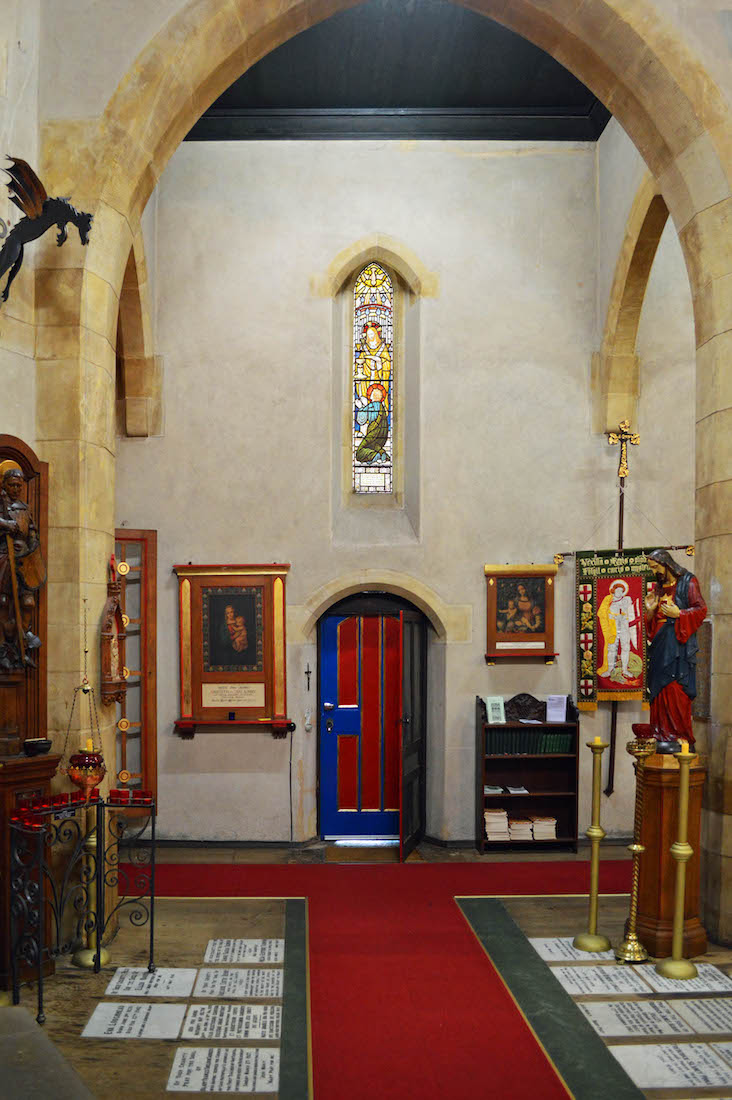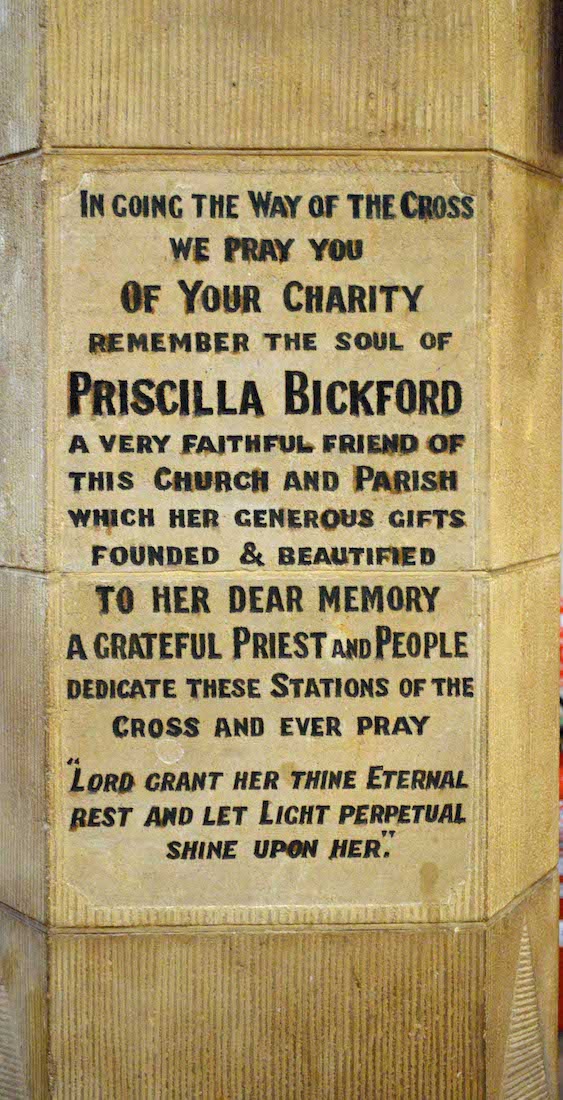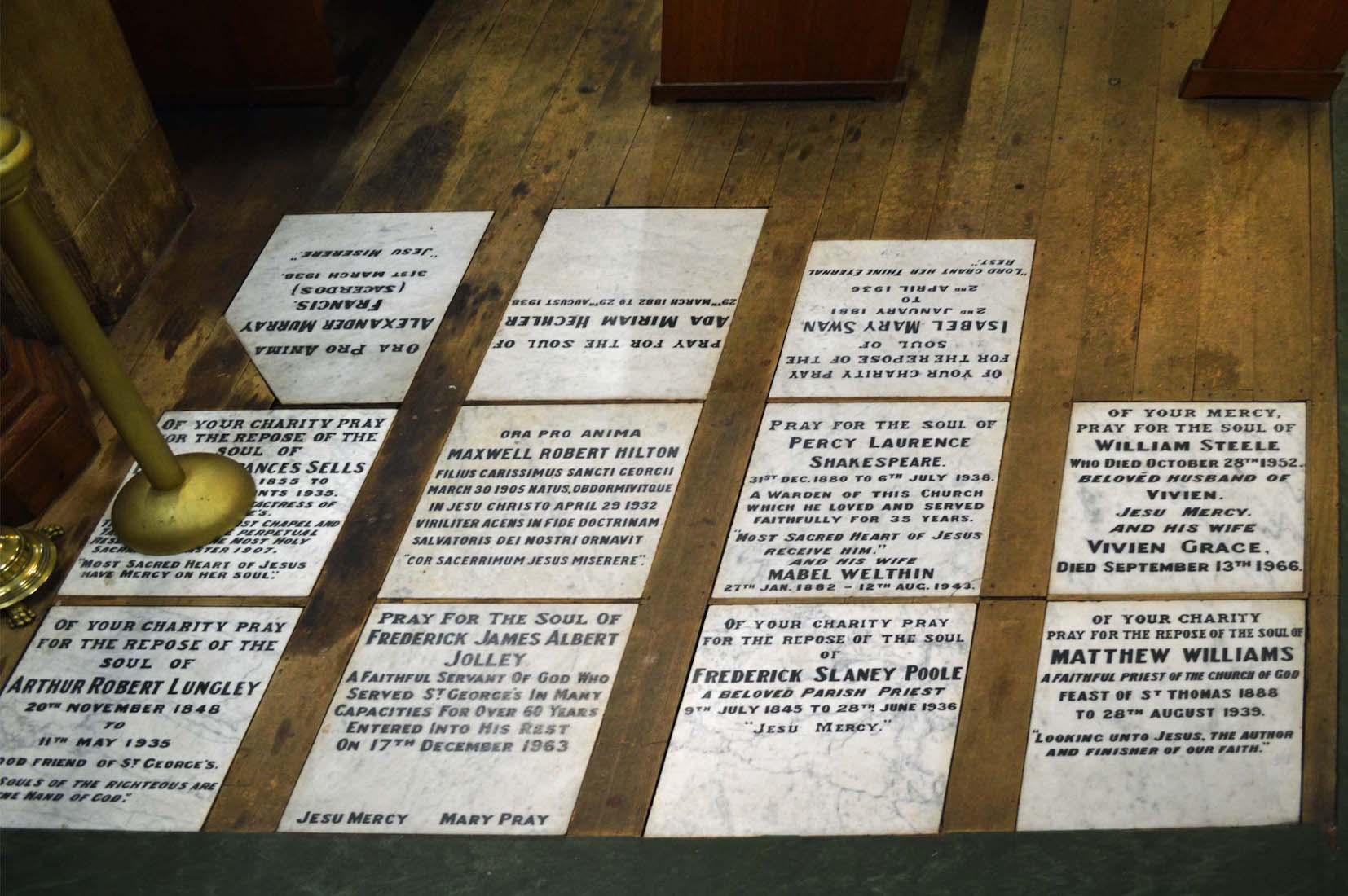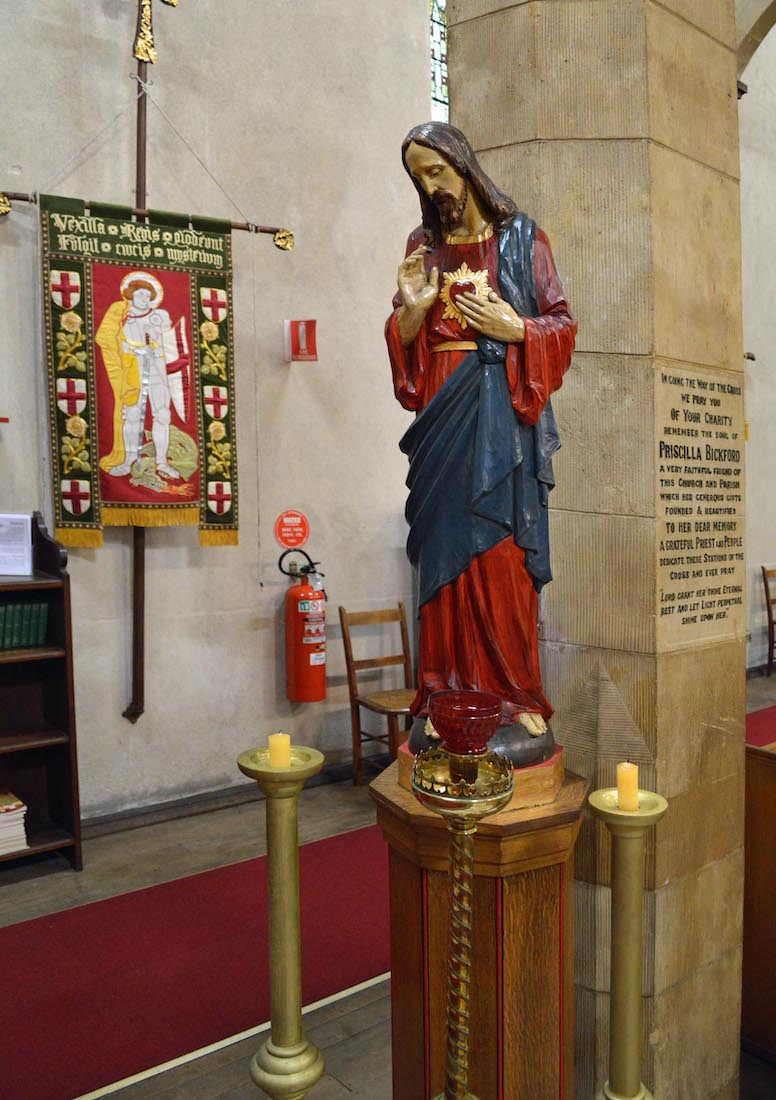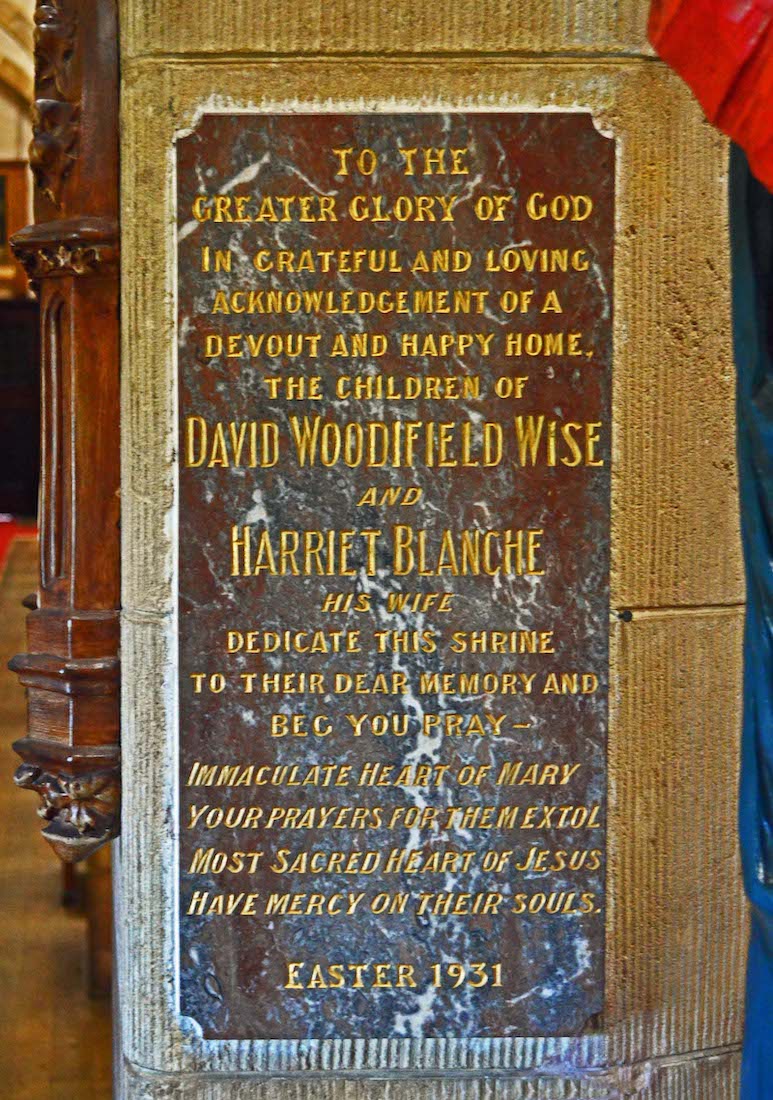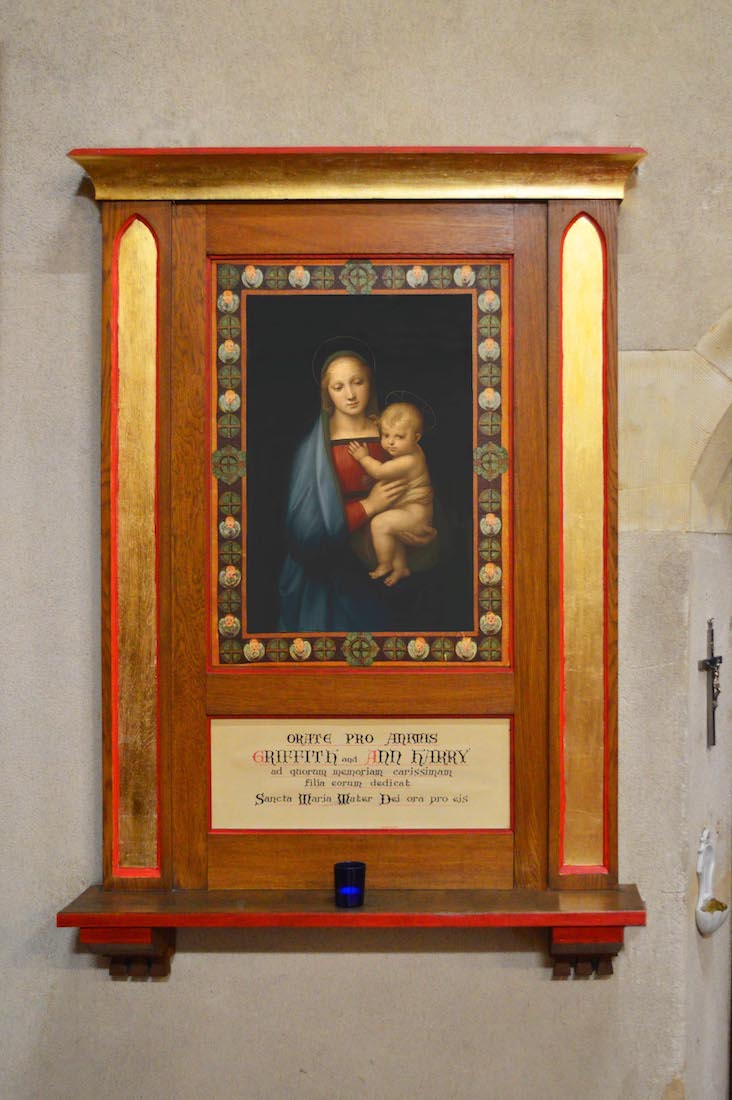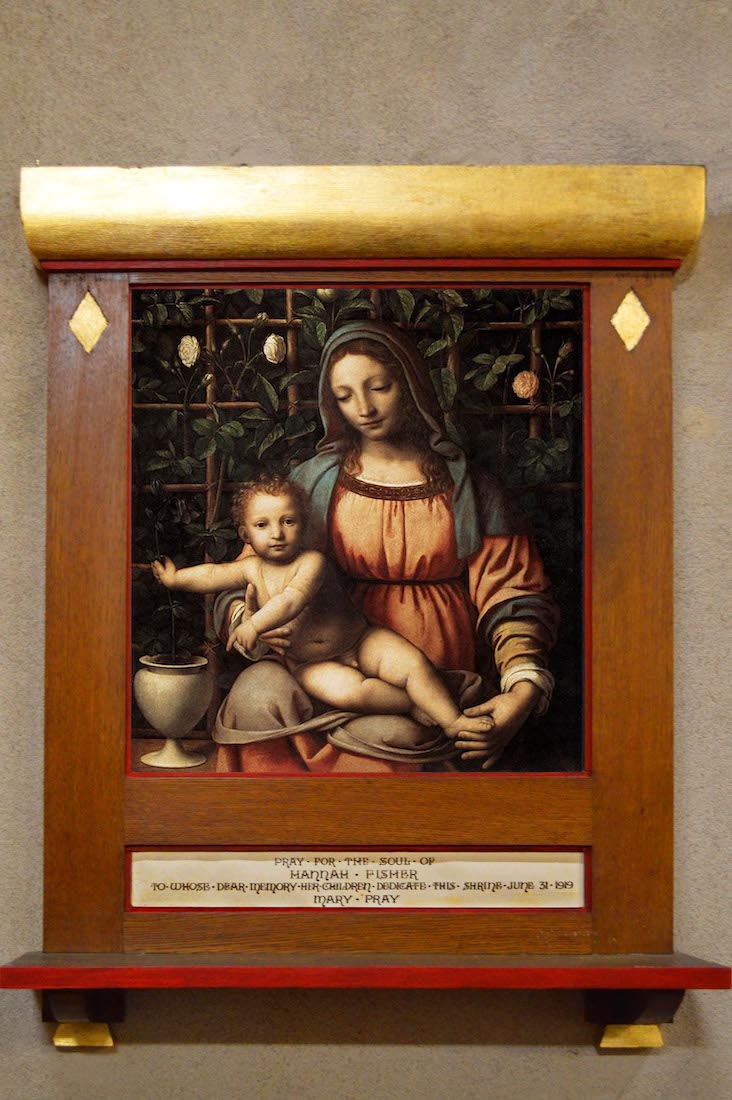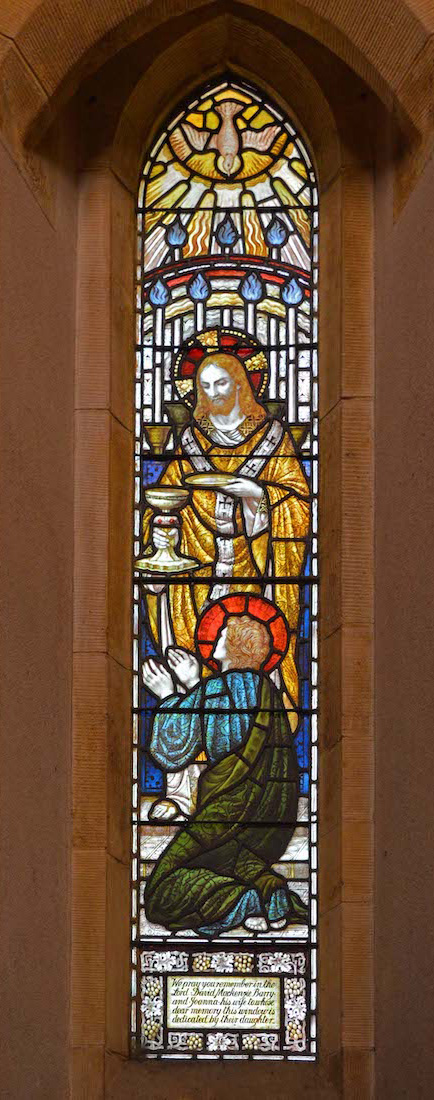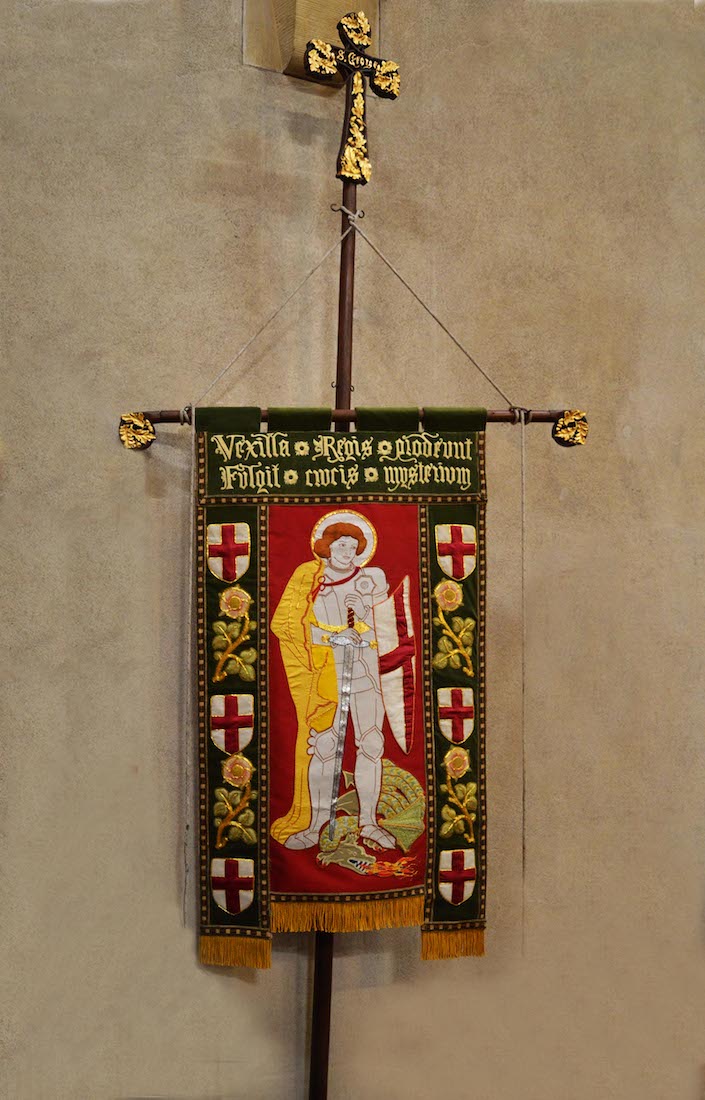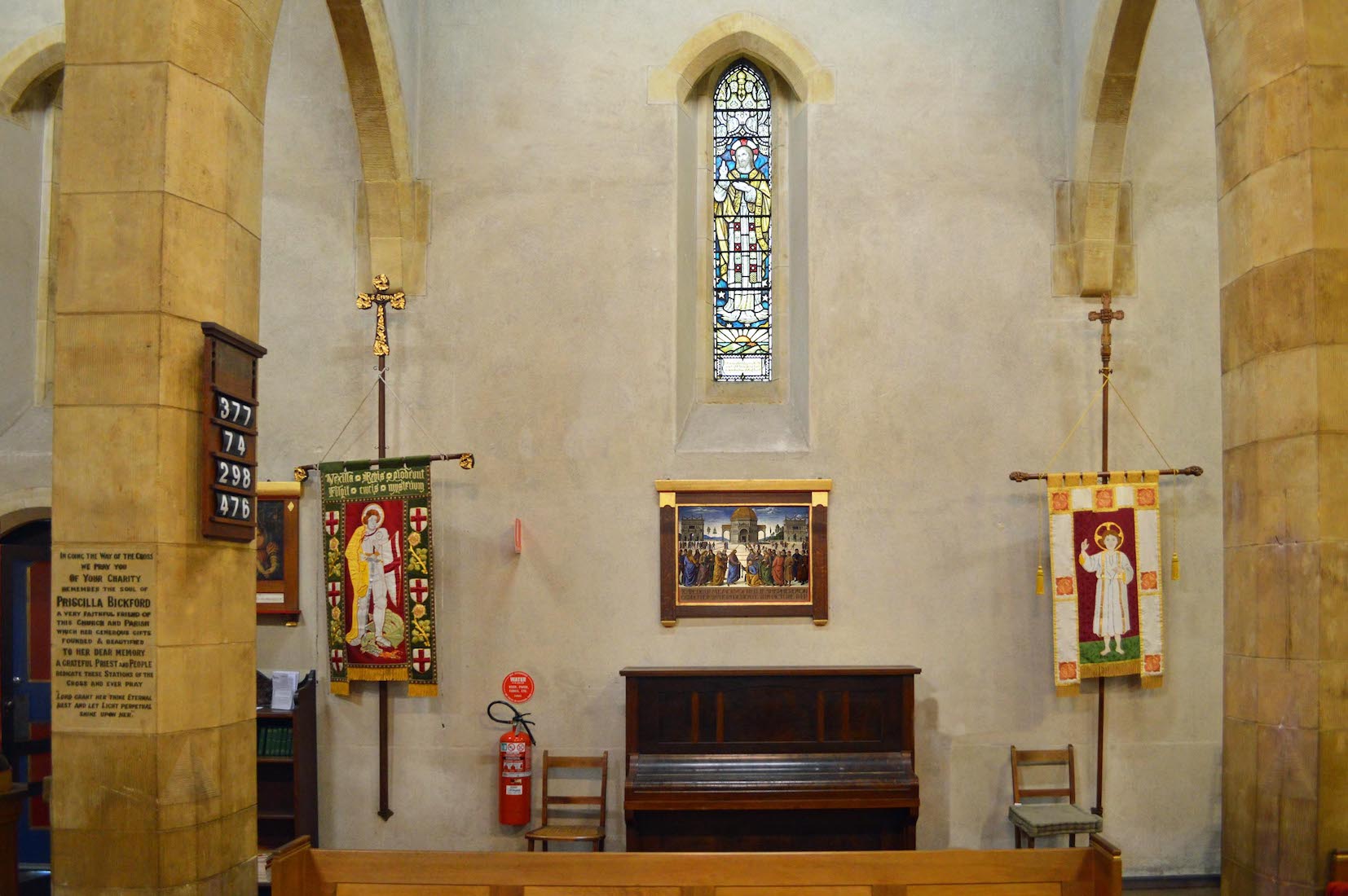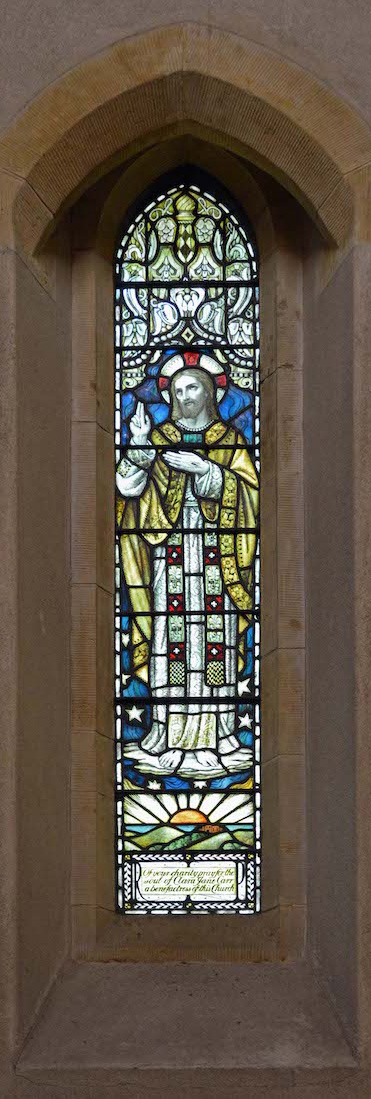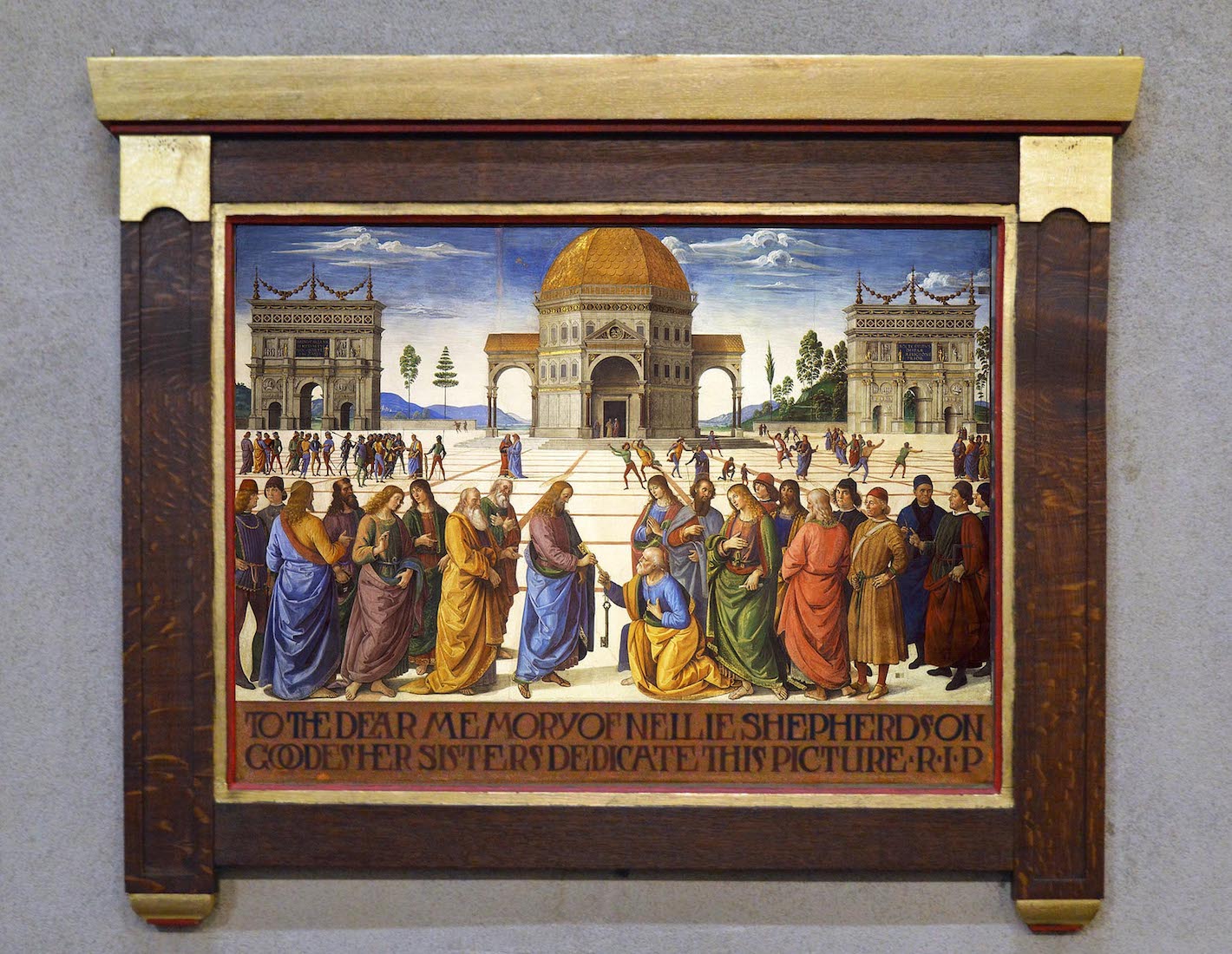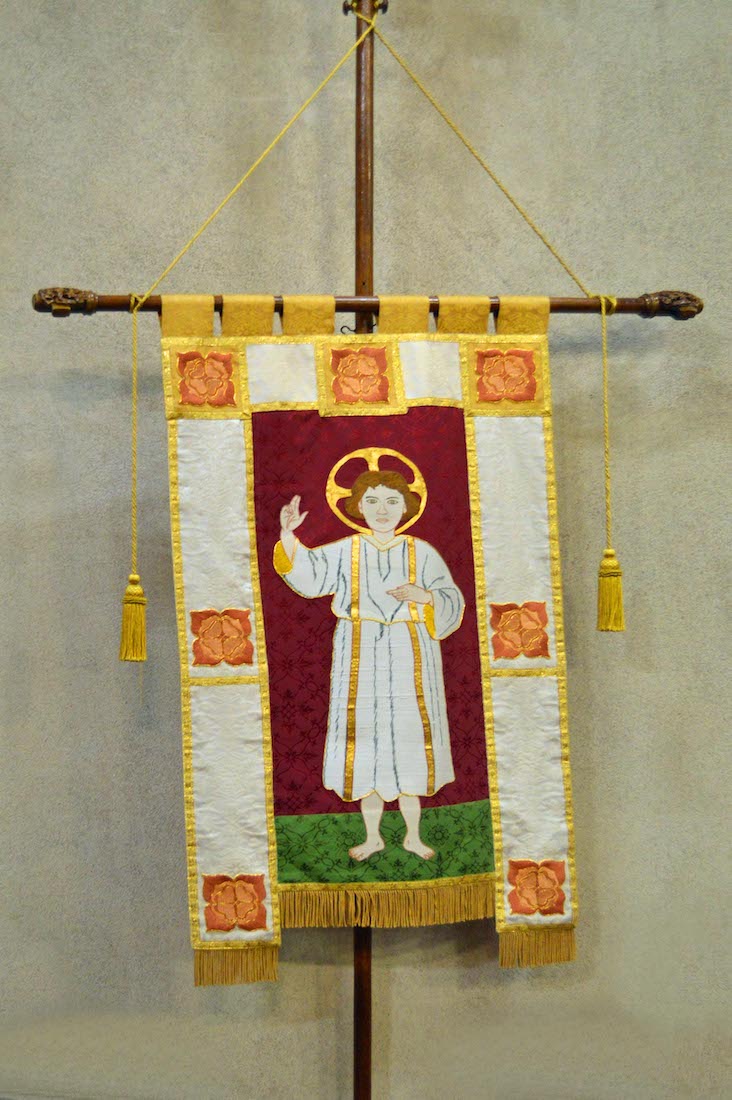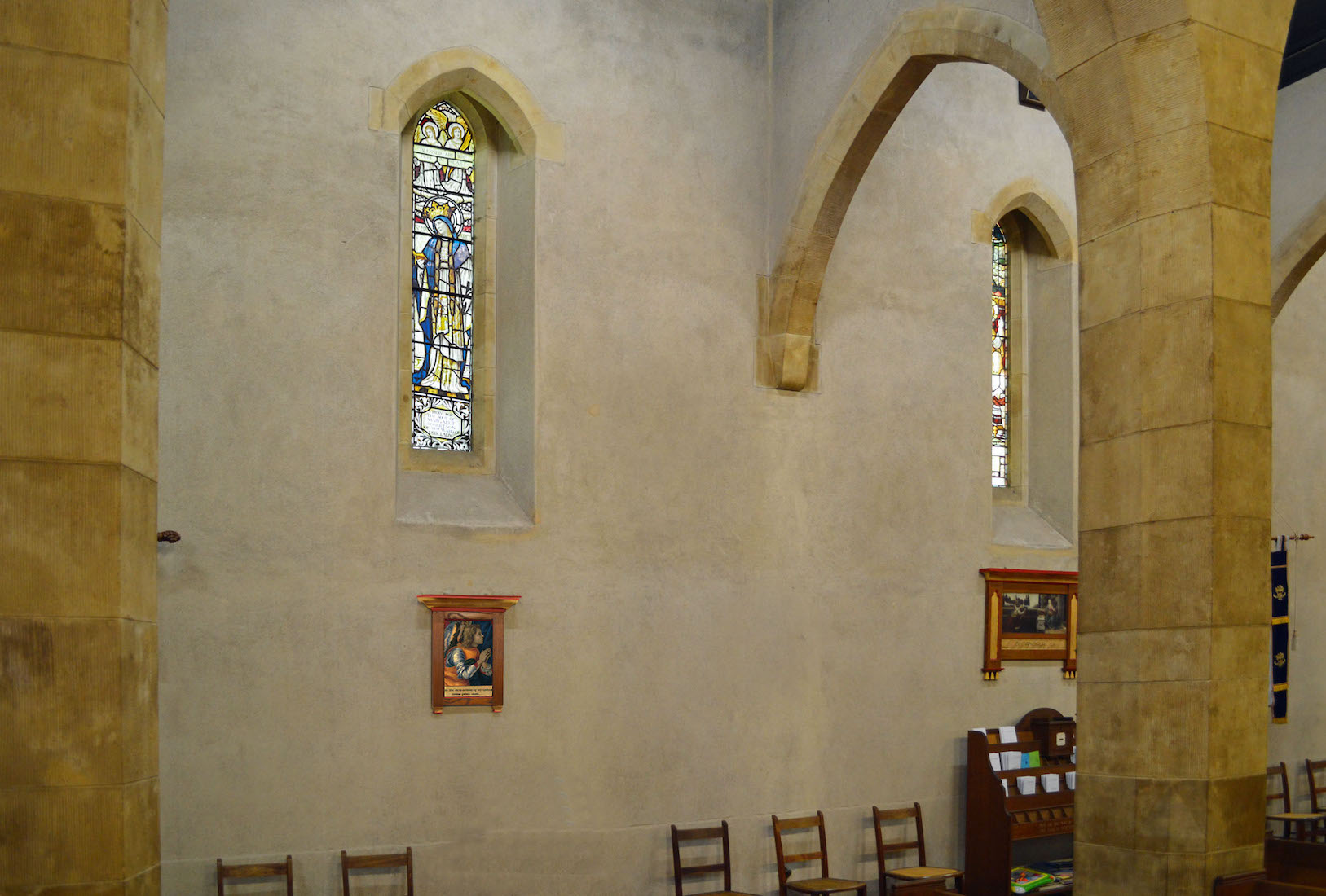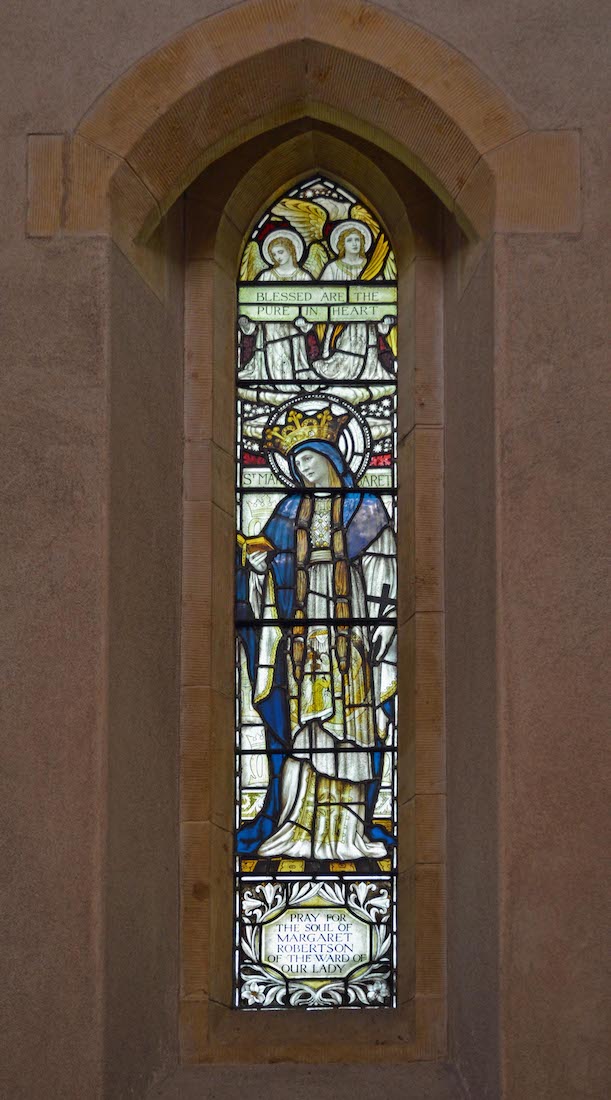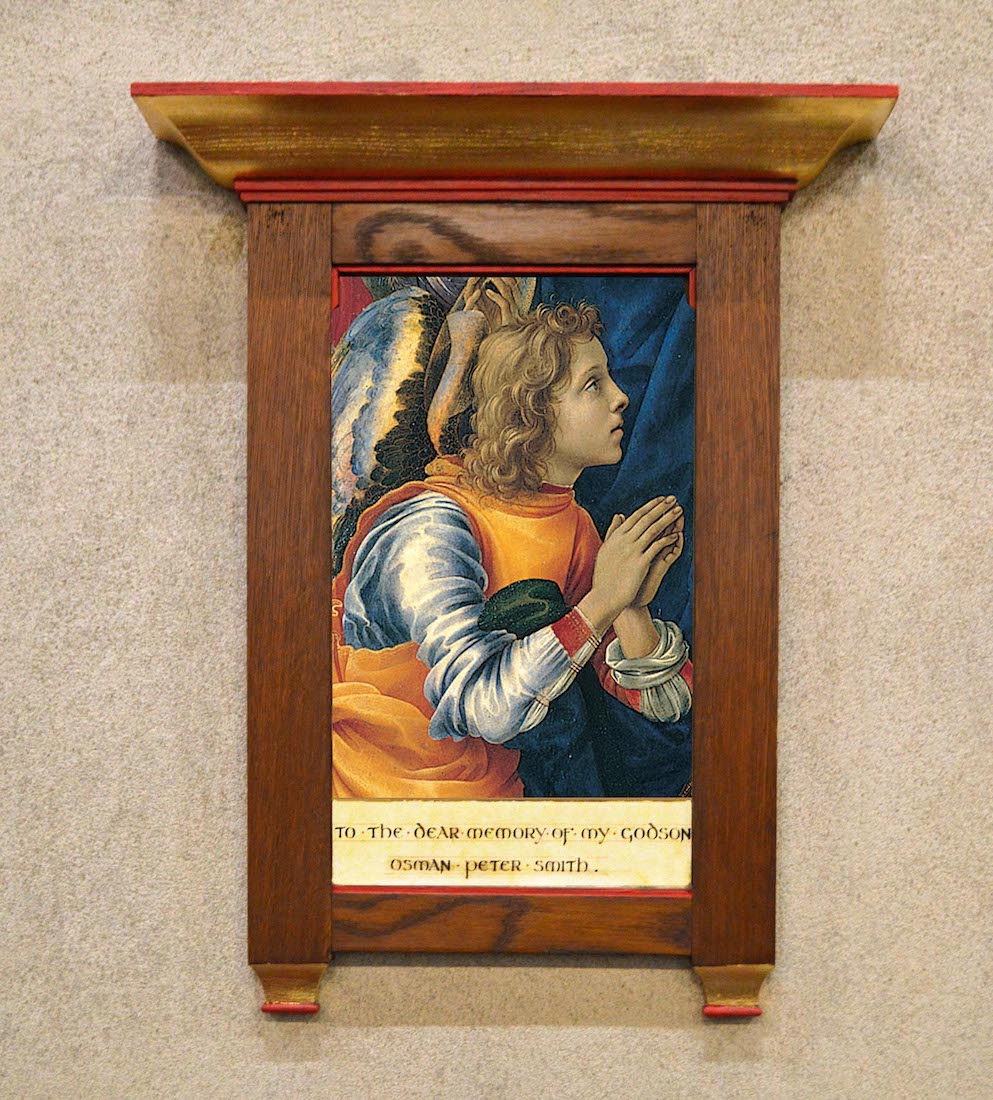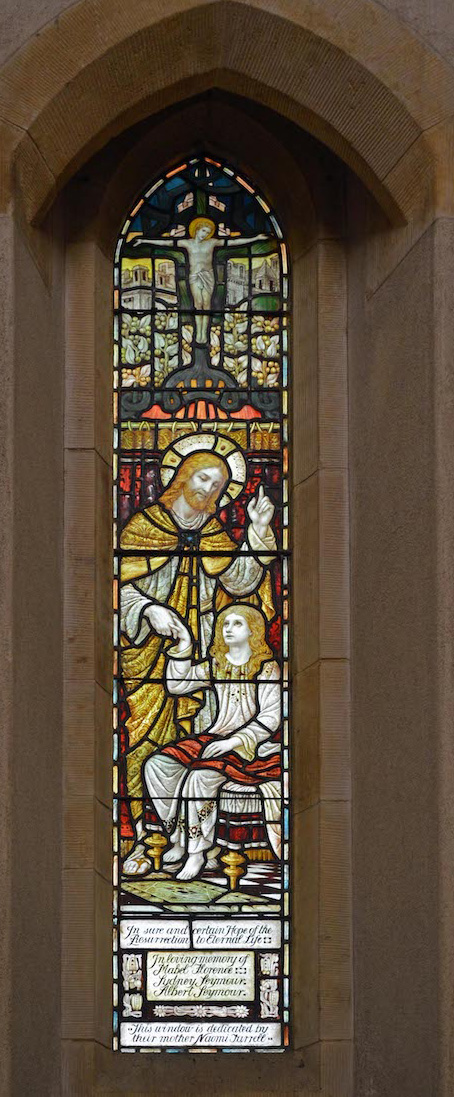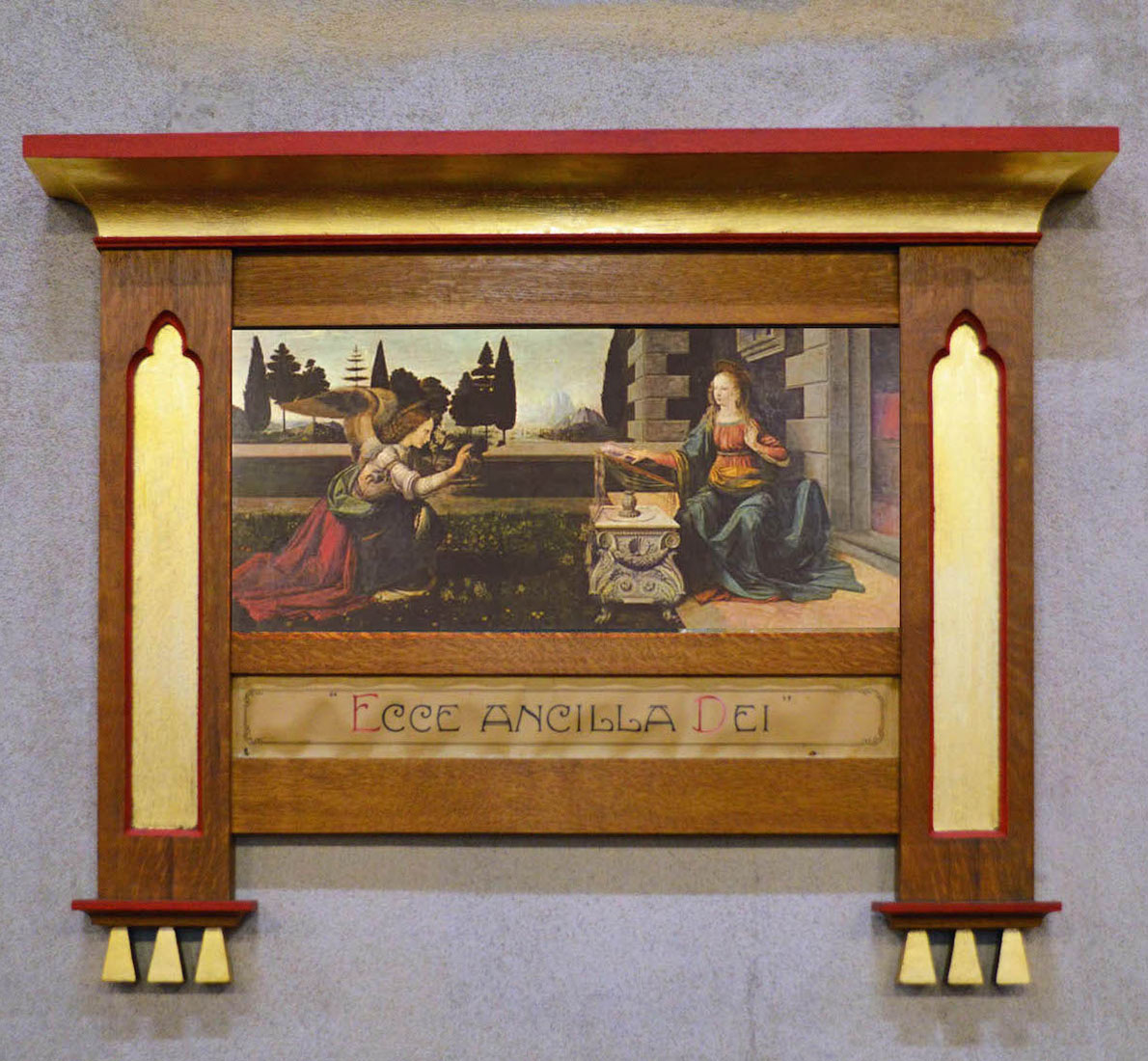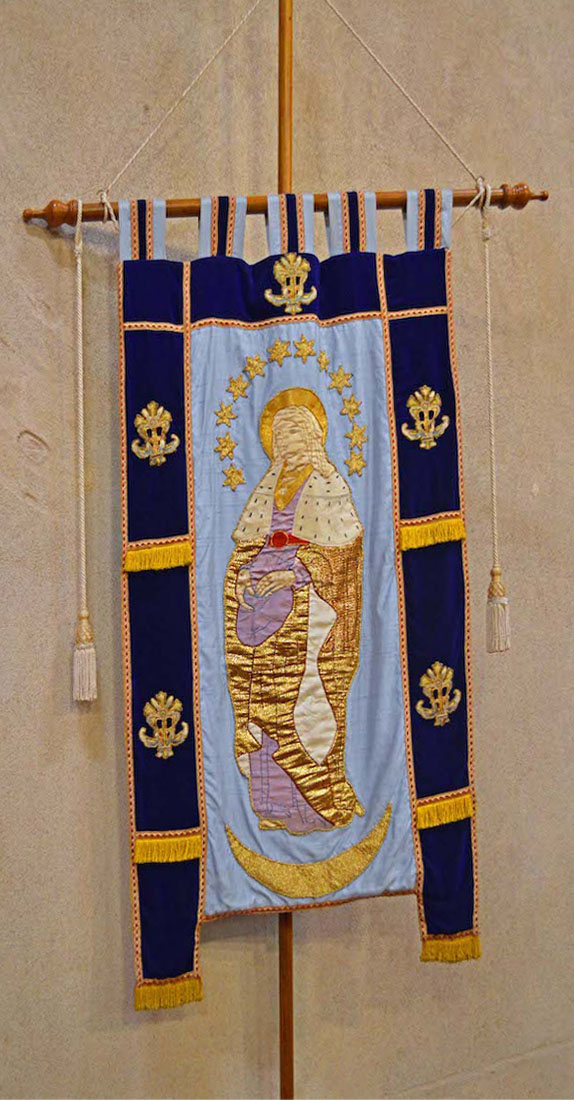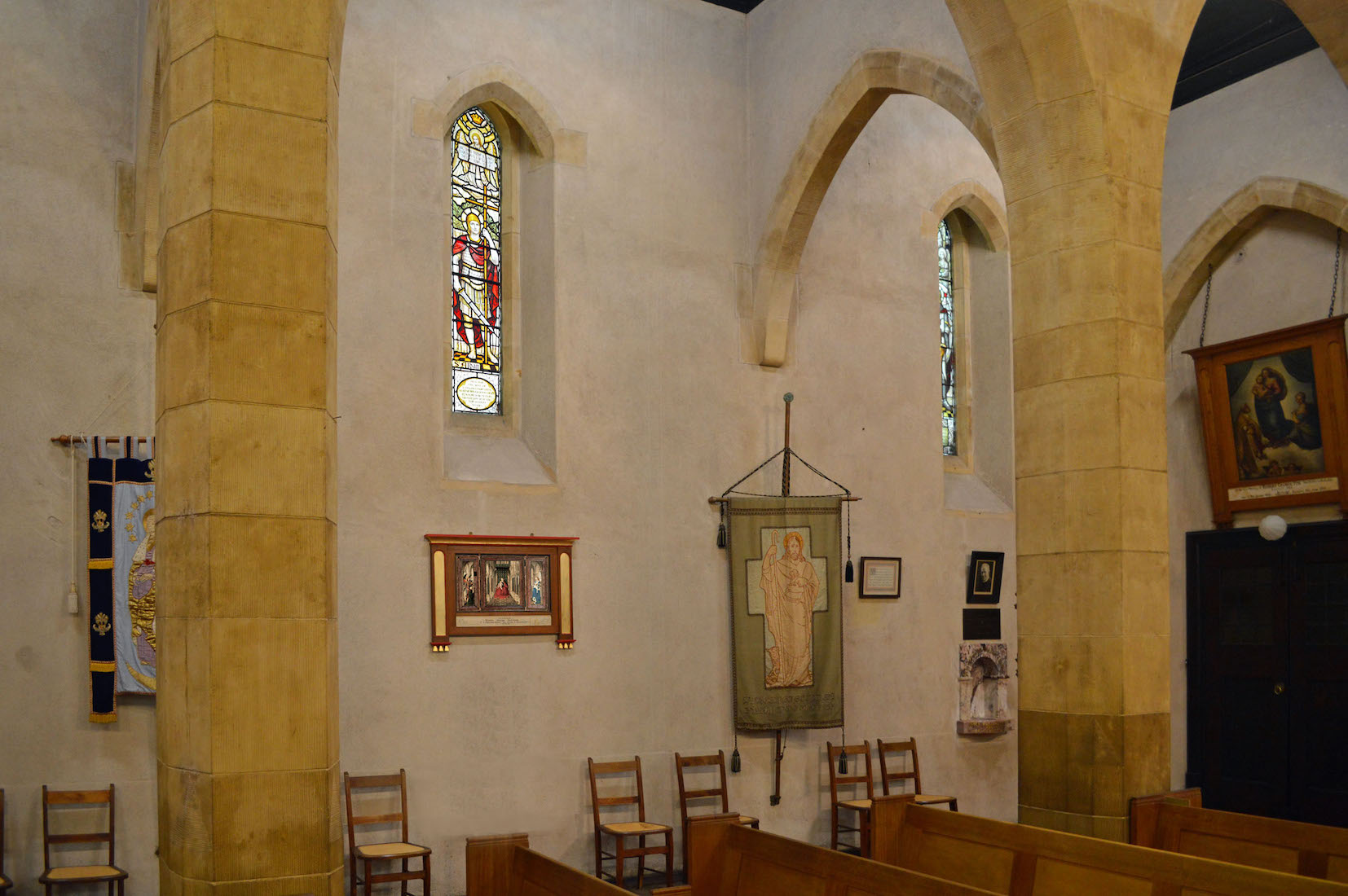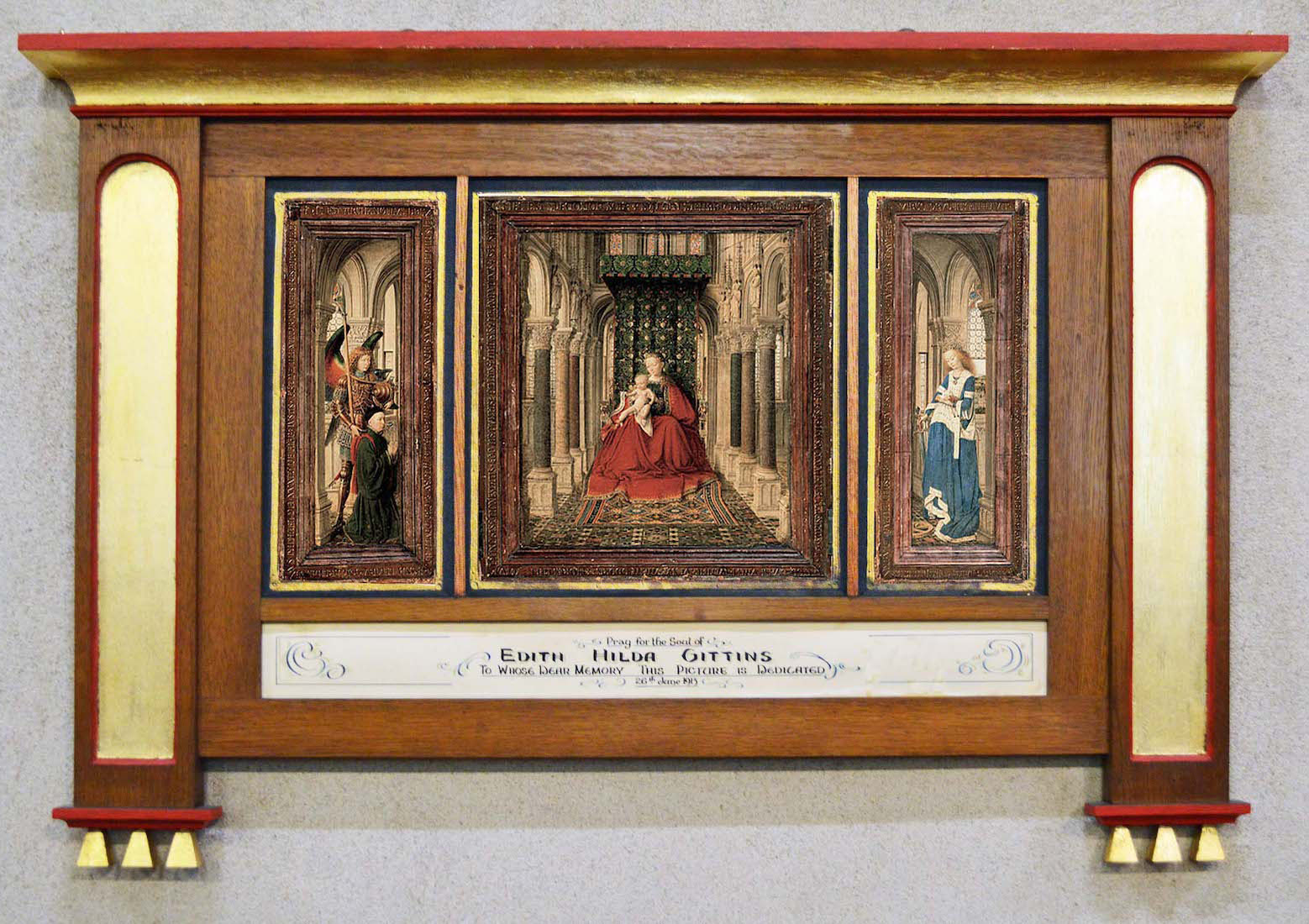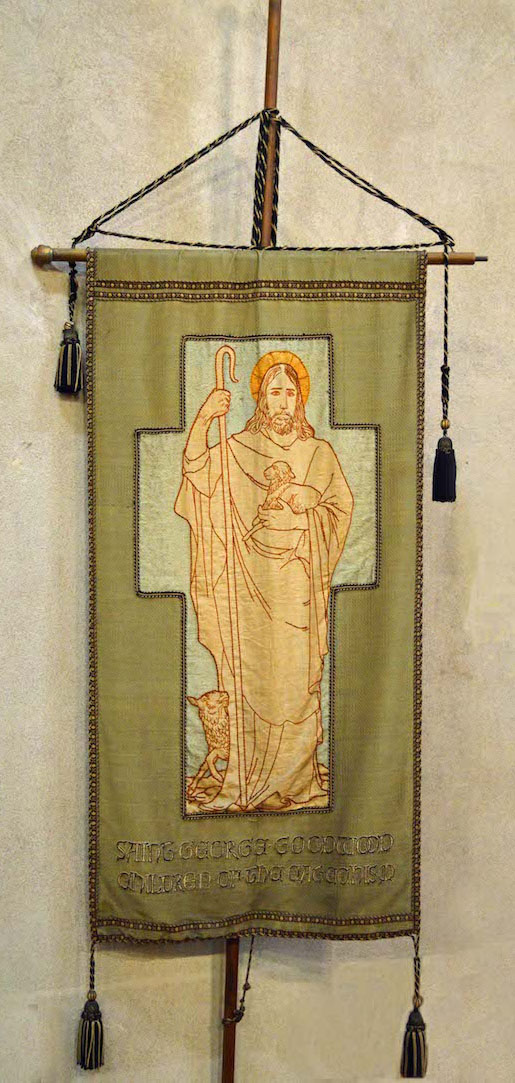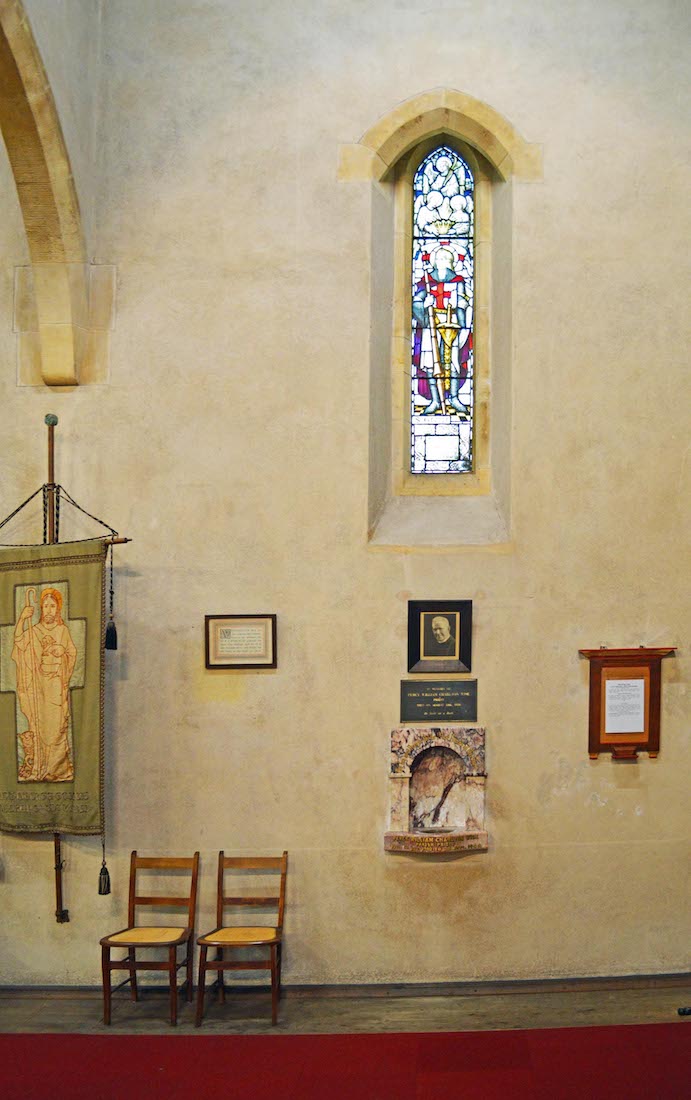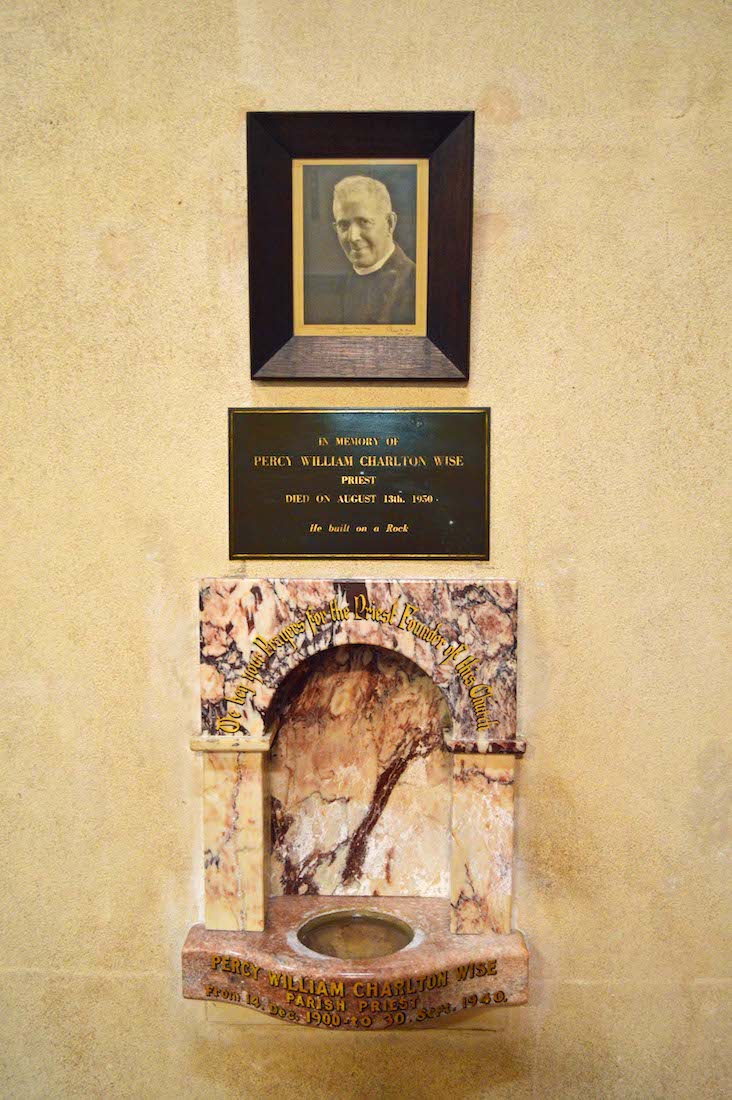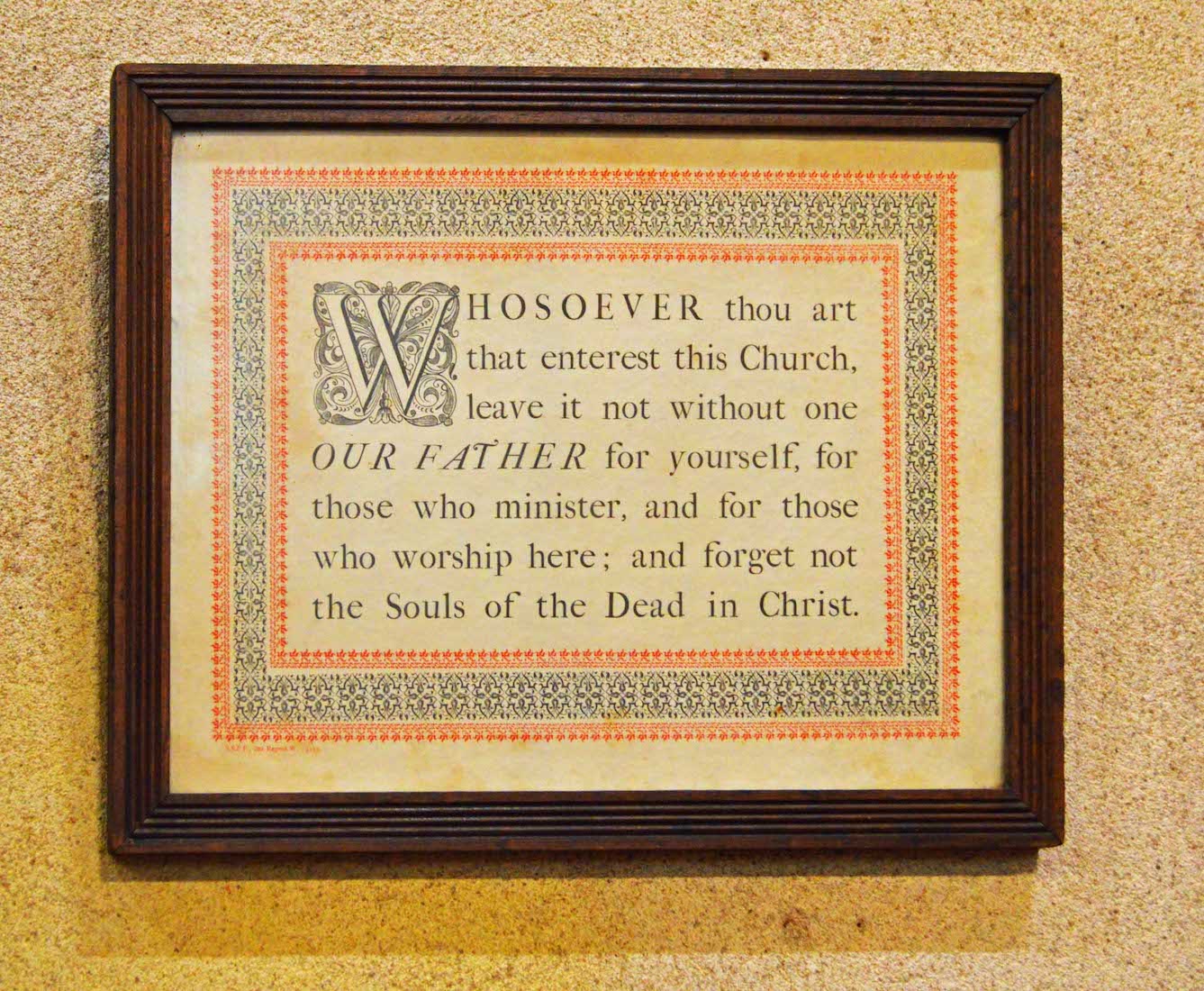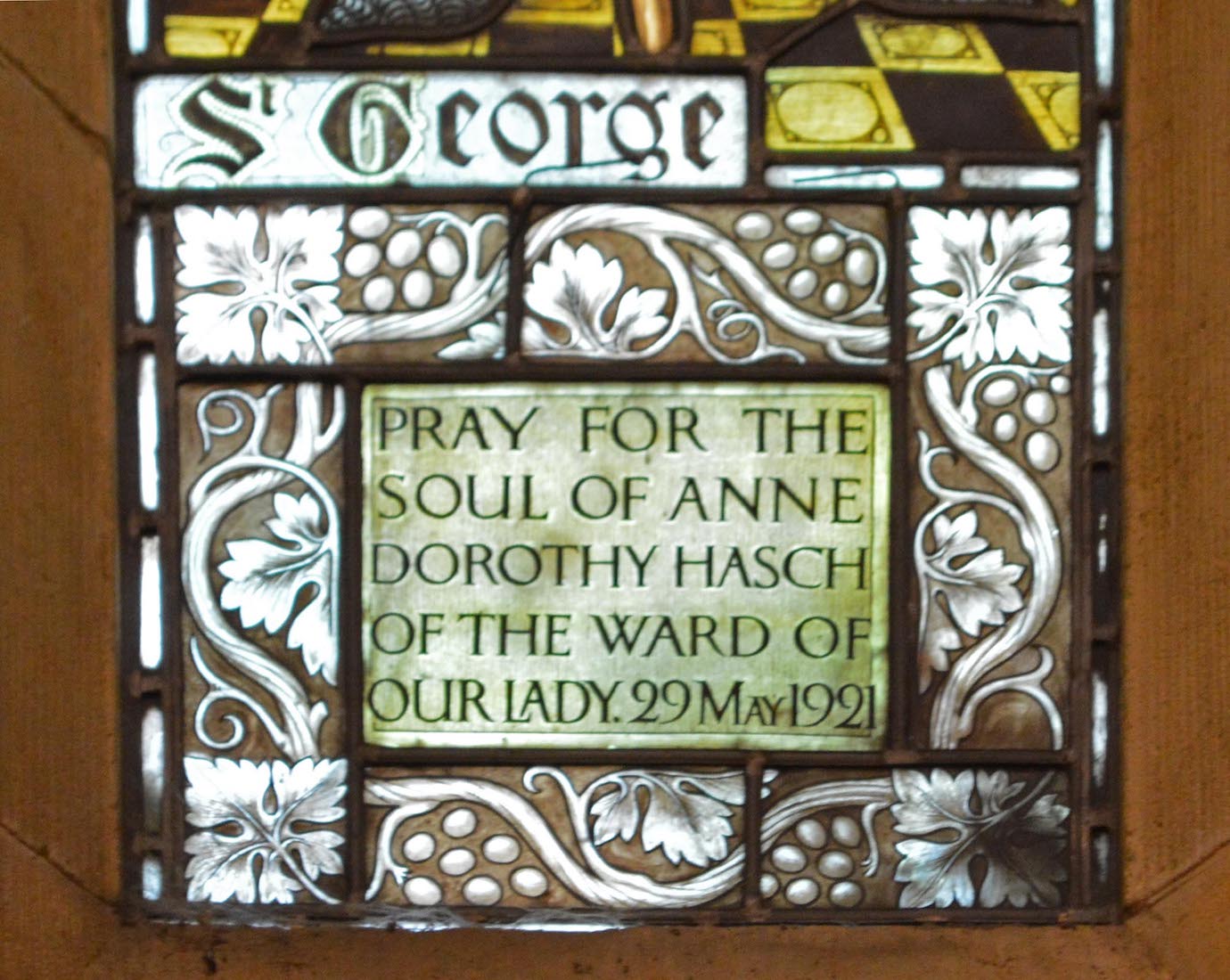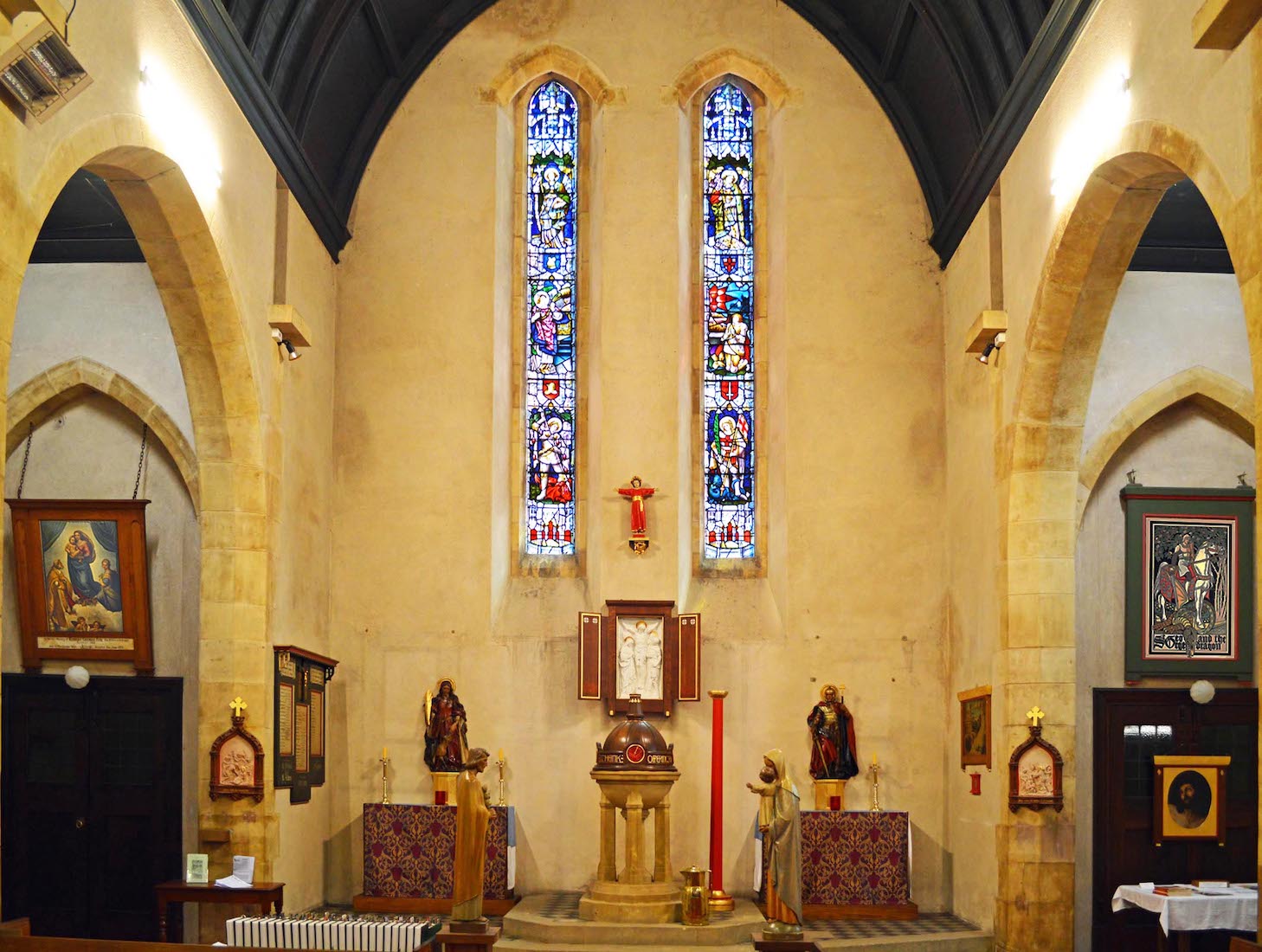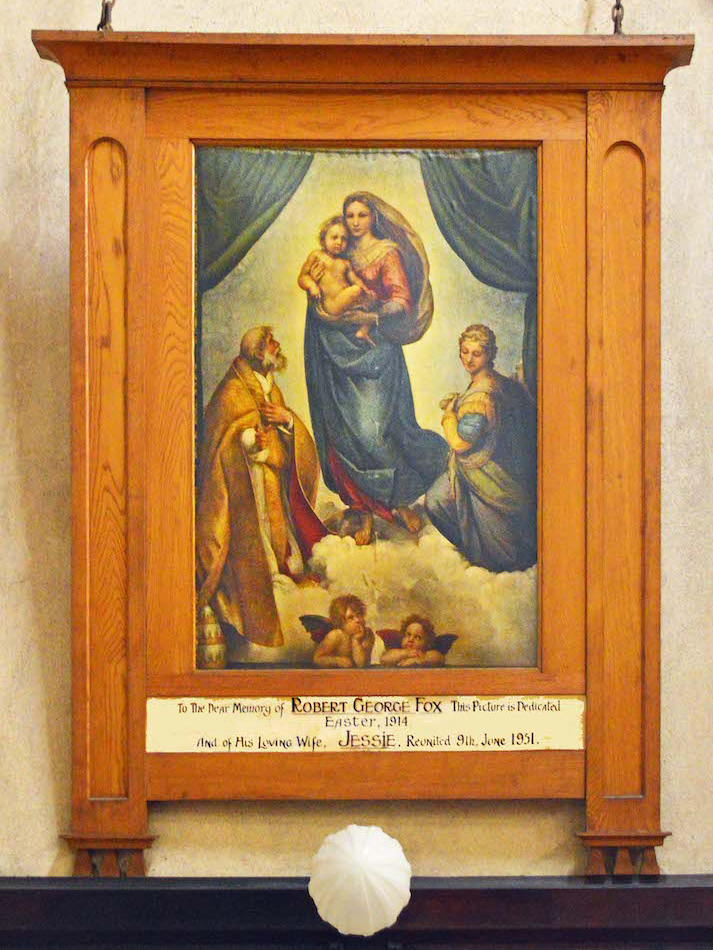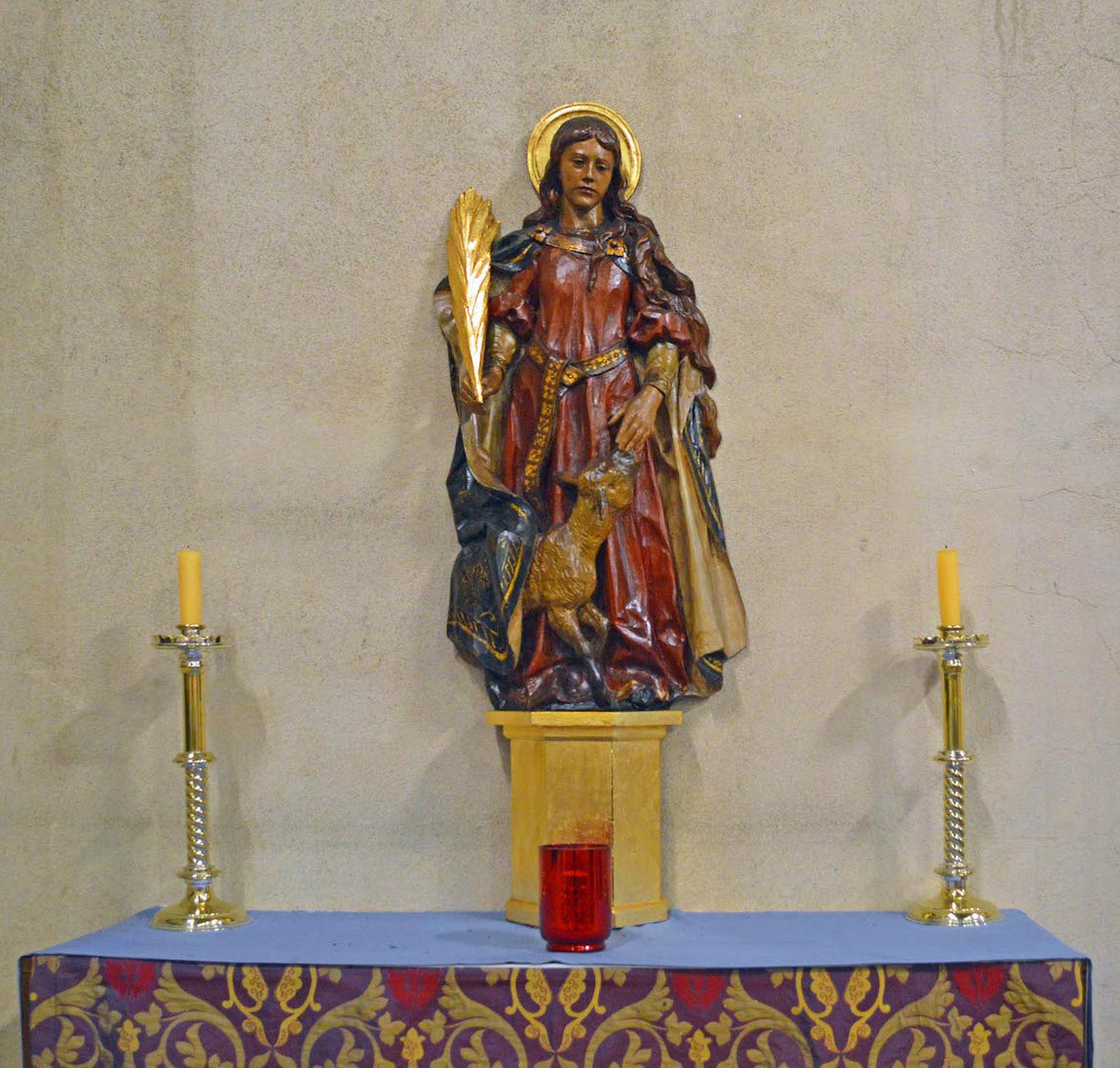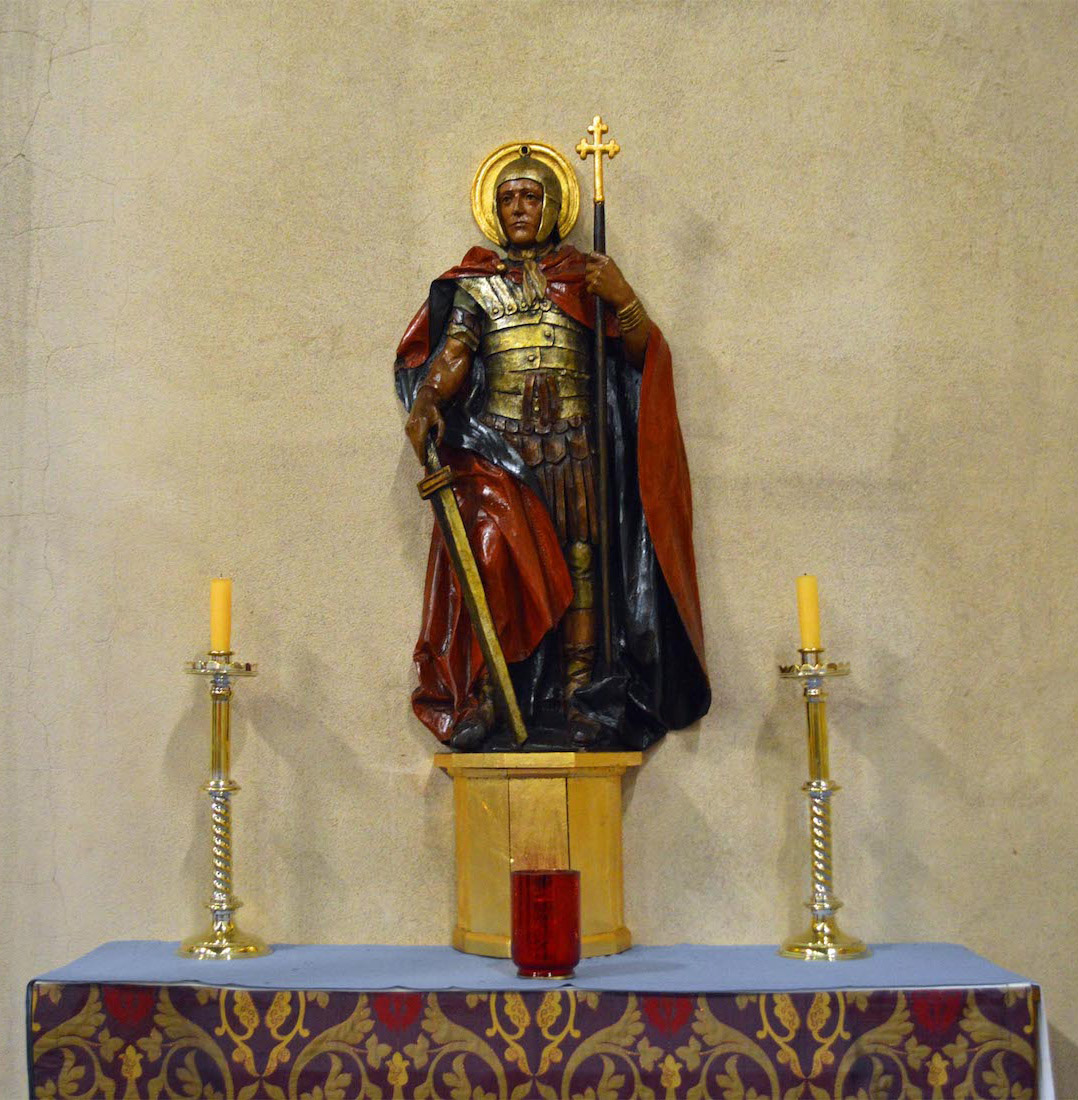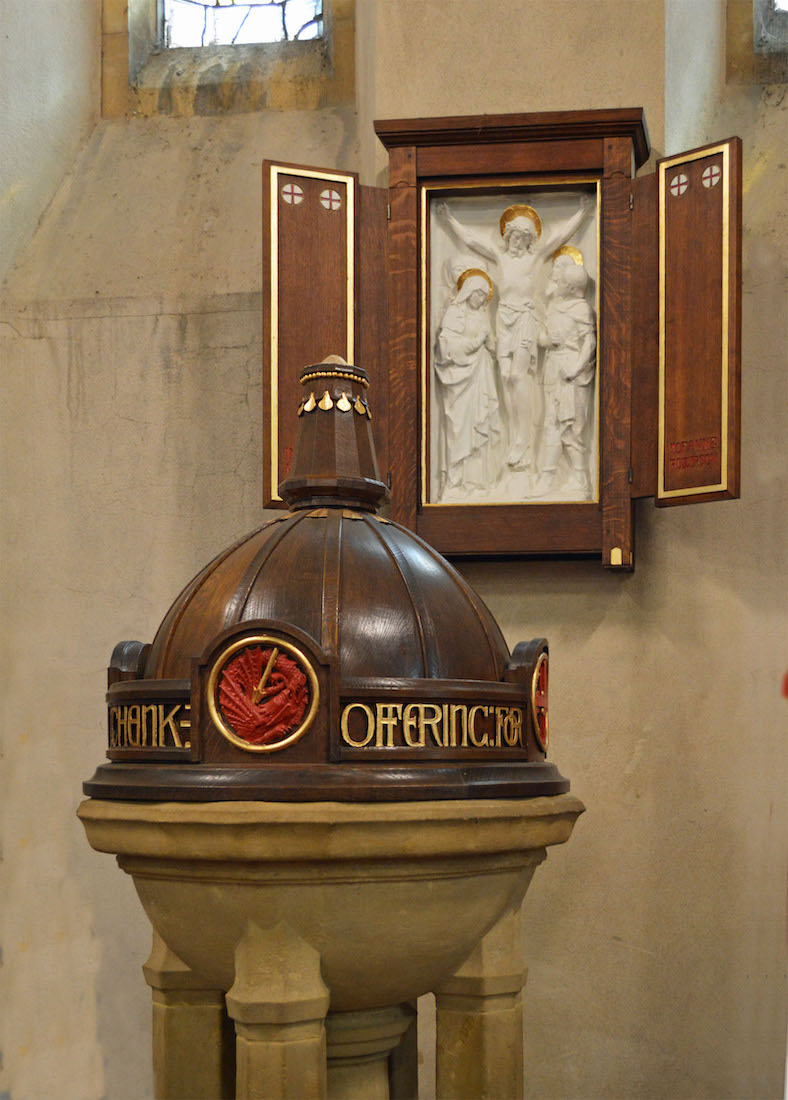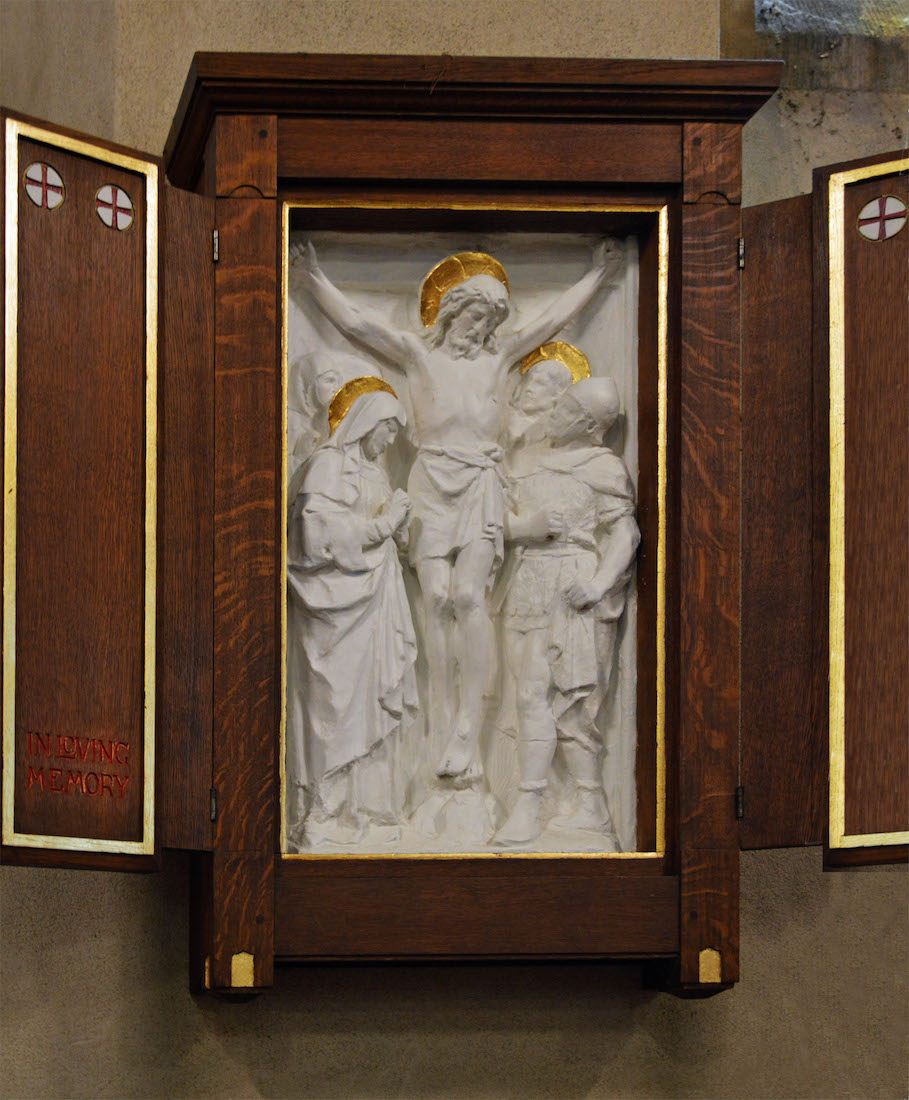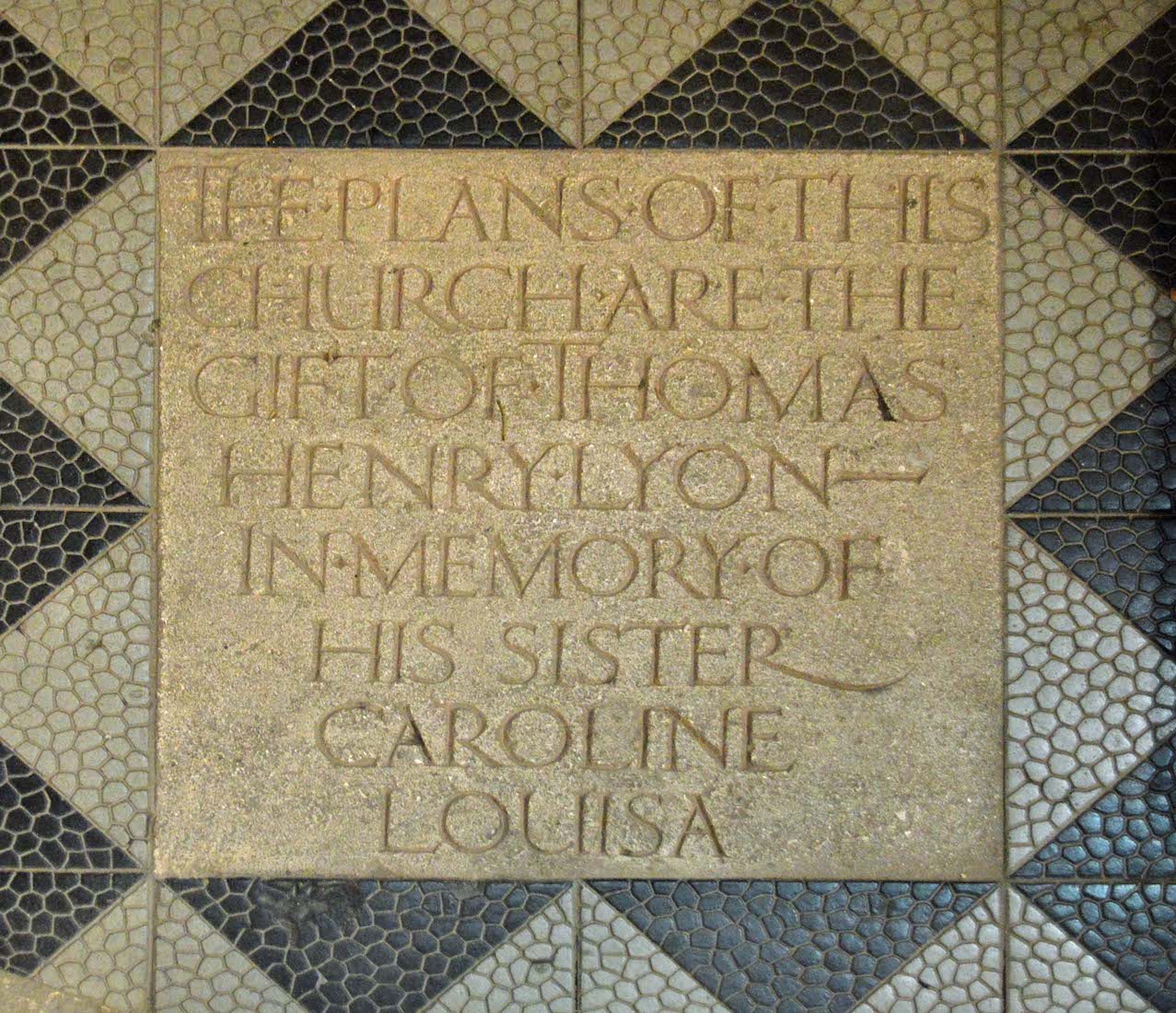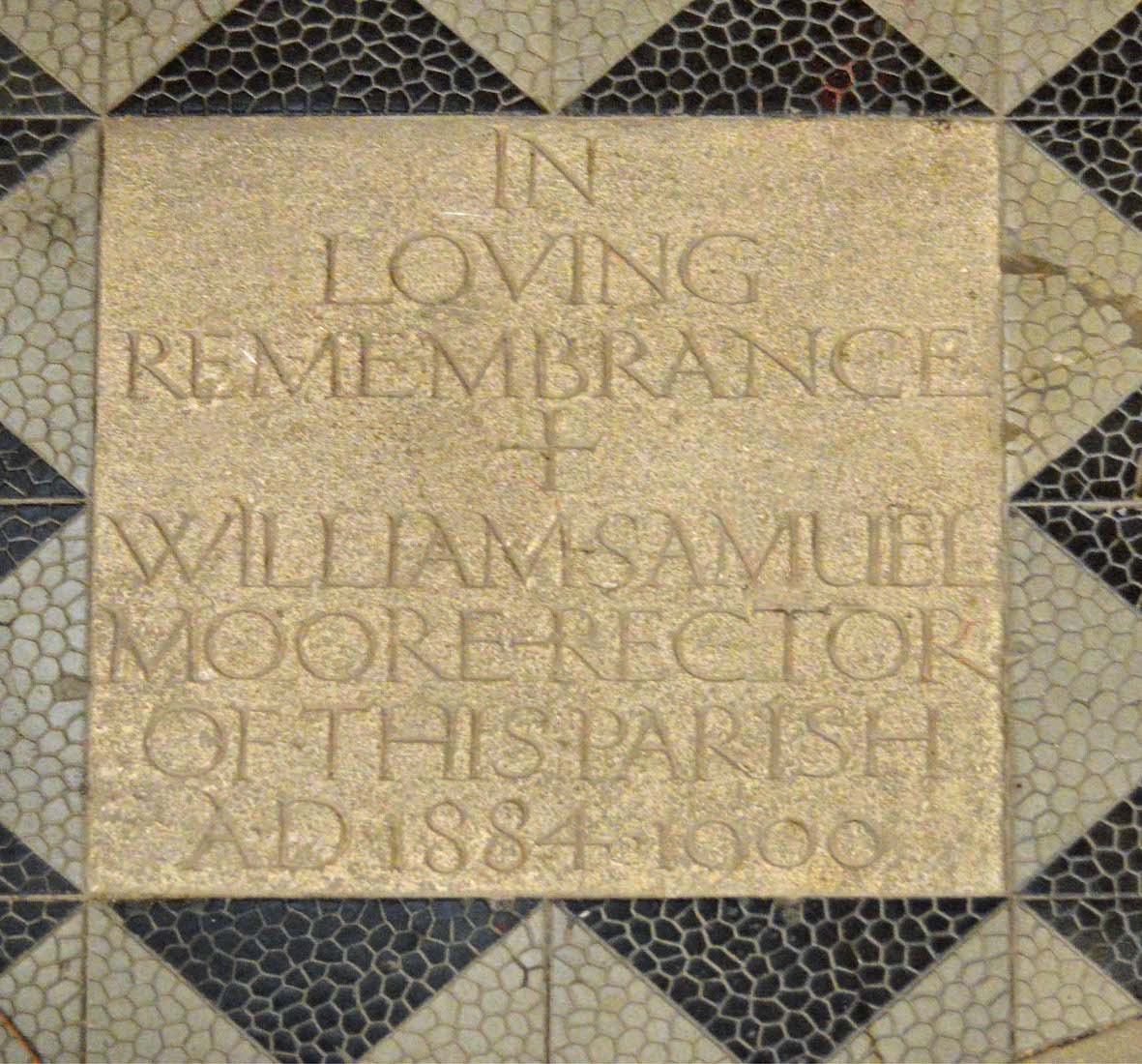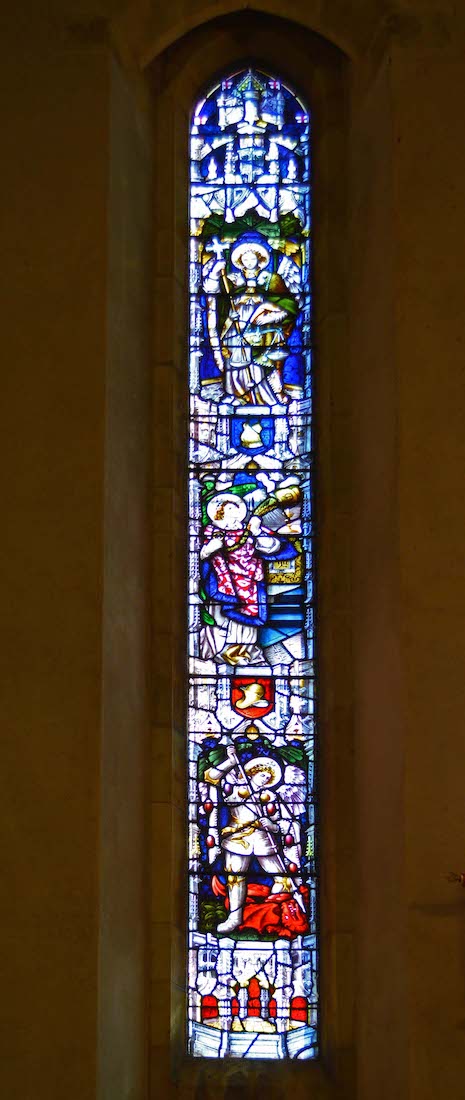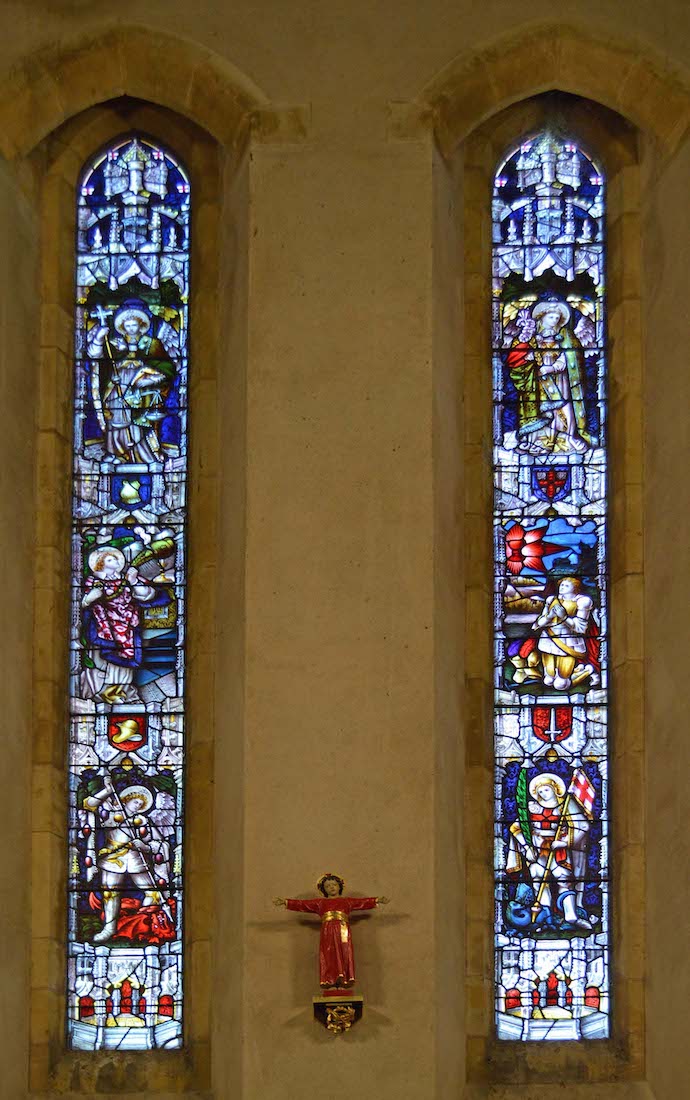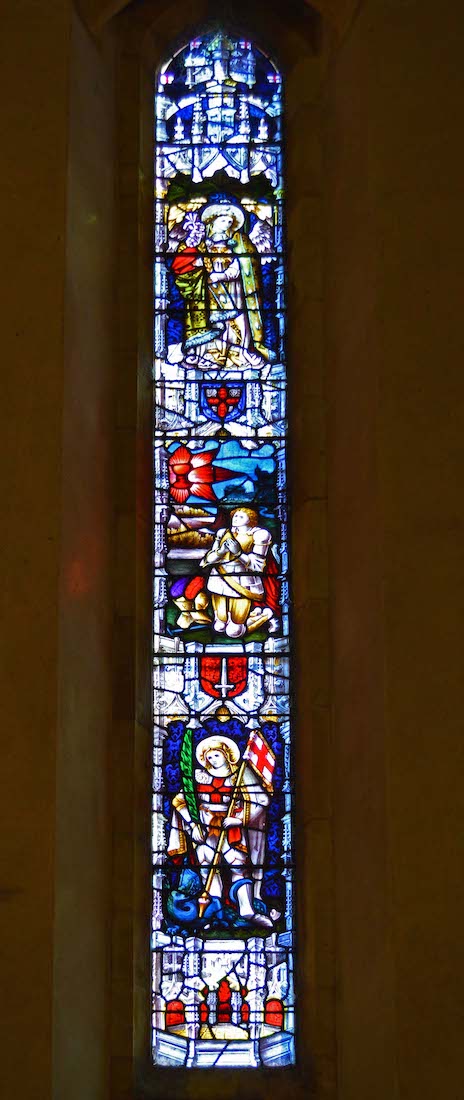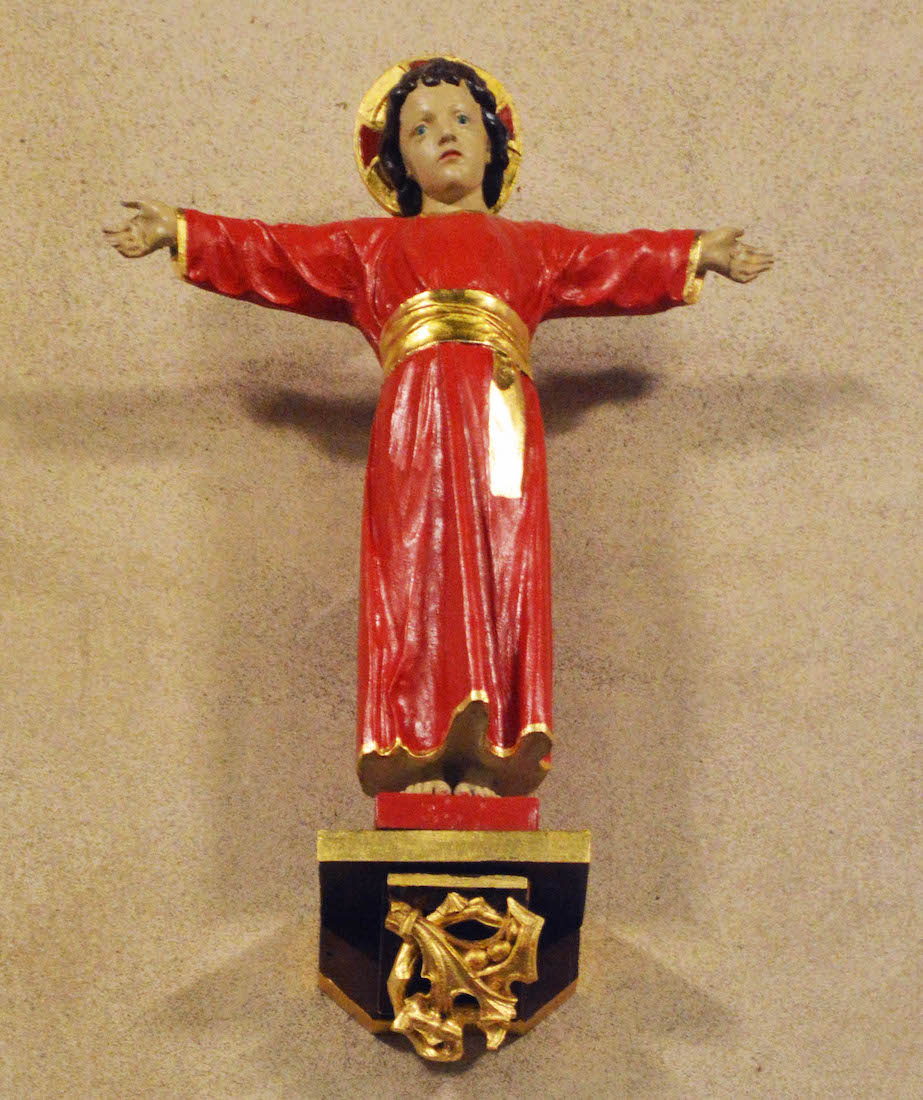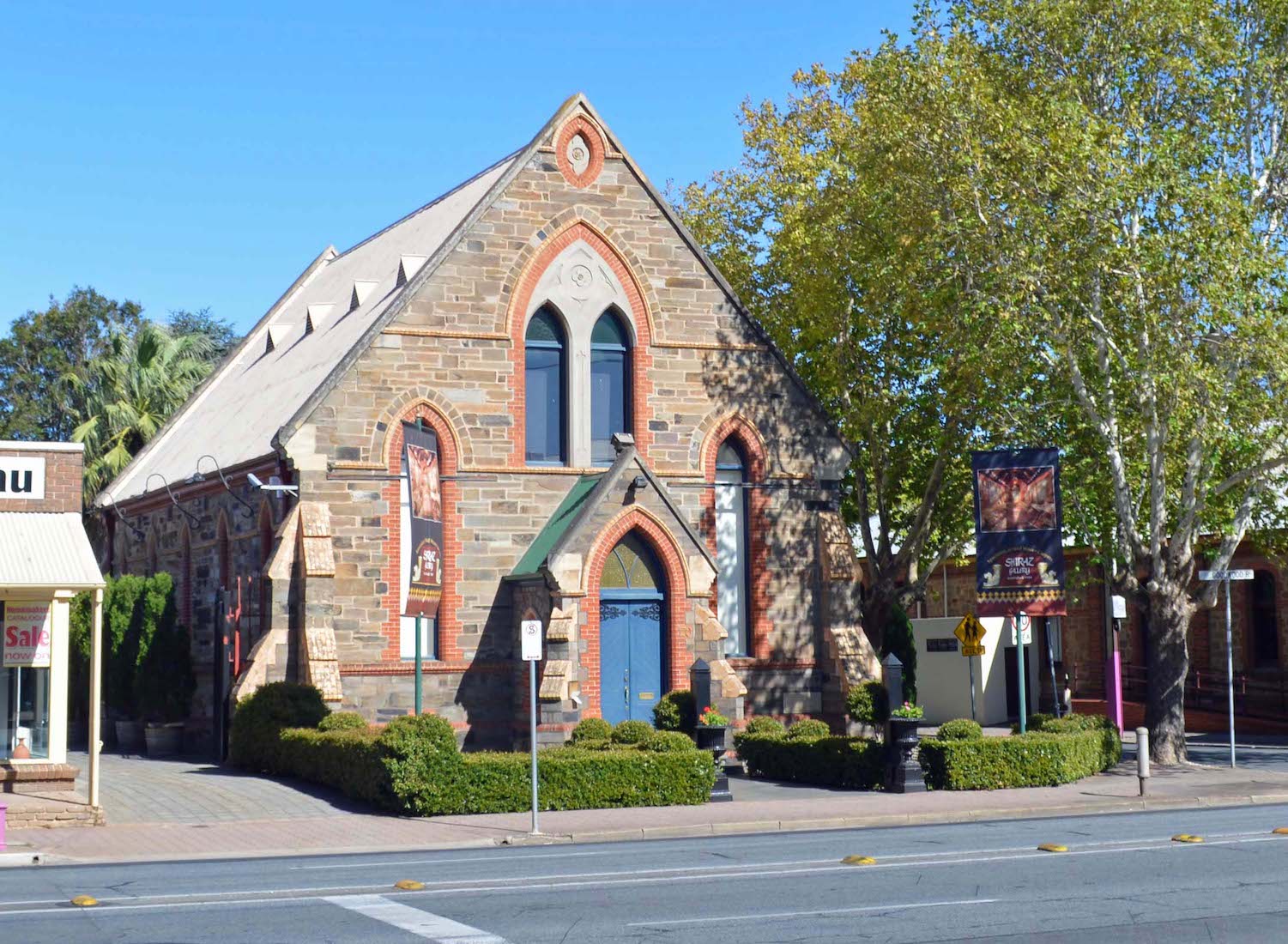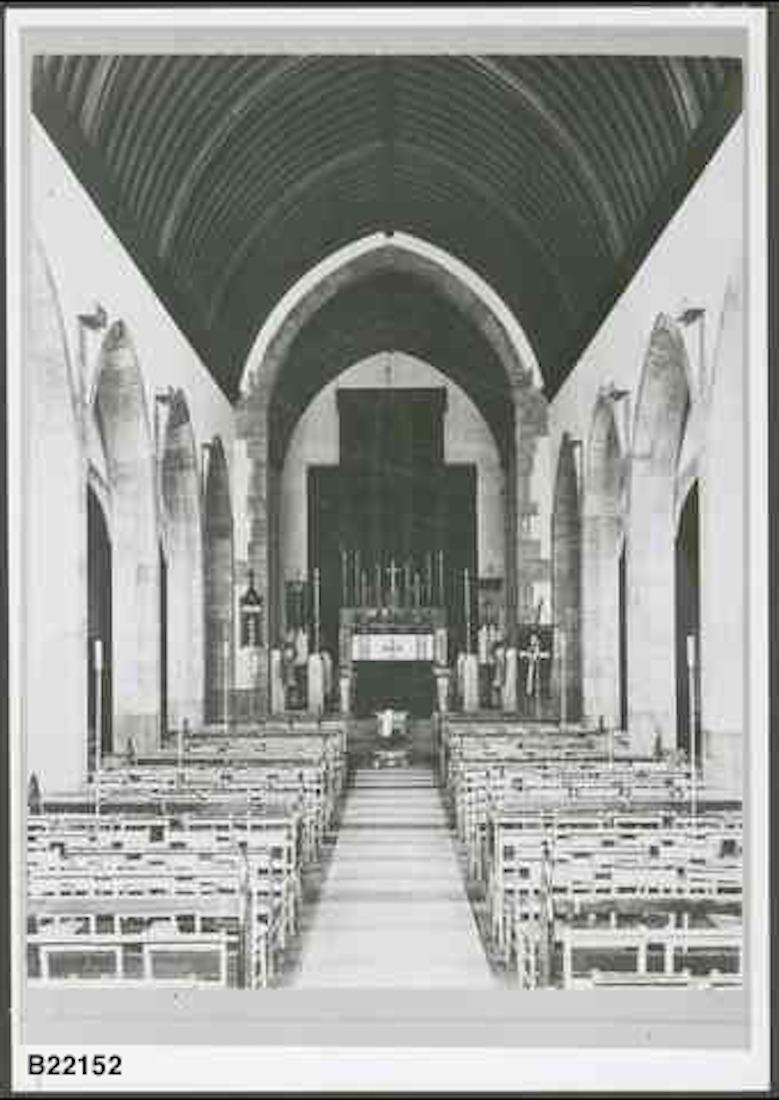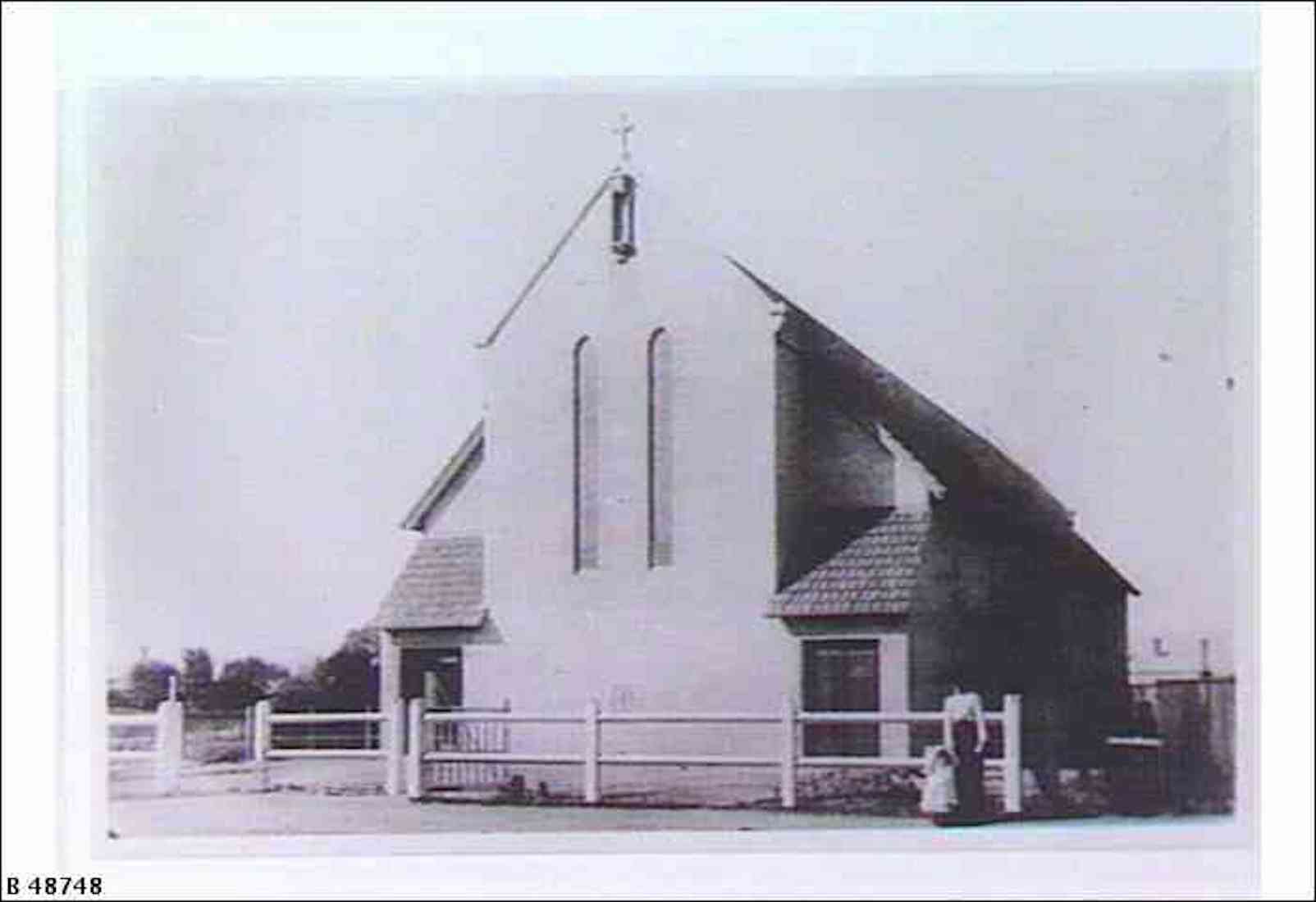33. SOUTH NAVE, BAY 6
Stepping down to the front of the nave, we look South to the side exit door. There is a glimpse of St George and the dragon at left, and one of the Stations of the Cross on the left column. Opposite stands a Sacred Heart statue. This was designed and executed by Mr Lyon and Mr Herbert Reed of Exeter. There is a plaque on the right column, dedicating the Stations of the Cross in memory of Priscilla Bickford. On the facing wall, we see two paintings and a window. On the floor are more of the marble memorial slabs. INDEX
34. SOUTH NAVE, BAY 6 (CONTINUED)
The painting on the left painted by Raphael in 1505 is known as the ‘Grand Duca Madonna’. This was given as a memorial to Griffith and Ann Harry. The painting on the right of ‘Madonna del Roseto’ was painted by Bernardino Luini, and was given in memory of Hannah Fisher. The window shows Christ as High Priest administering the sacrament. It was made by Powells of Whitefriars and was given in memory of David McKenzie and Joanna Barr. The St George banner dates from 1909 and has pole and cross designed by Lyon. The Latin words translate to ‘The Royal Banners forward go, the Cross shines forth in Mystic glow’.
35. SOUTH NAVE, BAY 5
We move along the South wall to the 5th bay of the nave. The window shows Christ as Priest with hand raised in blessing and is a memorial to Clara Jane Carr. The painting by Raphael’s teacher Peitro Perugino shows the commissioning of St Peter, and is a memorial to Nellie Shepherdson Goodes. It was dedicated on Easter Monday 1910. The banner at right is the Christ Child banner, also referred to as the Holy Child. The Guild of St Mary of Bethany created the banner and it was dedicated at Easter, April 1916. It shows a youthful Christ standing and giving a blessing. The banner was remade recently by Ross Menhennitt.
36. SOUTH NAVE, BAYS 4, 3
The window shows St Margaret of Scotland and is in memory of Margaret Mary Robertson of the Ward of Our Lady. It was a gift to St George's, and was made by Powells of London in 1921. The little painting beneath of the adoring angel is a detail from the painting ‘Madonna appearing to St Bernard’ by Filippo Lippi. It is a memorial to Osman Peter Smith. The original is in the Badia Fiorentina, an abbey in Florence.
37. SOUTH NAVE, BAY 3
The window shows the raising of Jairus’ daughter. It was given in memory of the Farrell family in 1904. It was made by Jas Powell and Sons and the Whitefriars Glassworks. The banner is the ‘Our Lady as Queen of Heaven’ banner, and was dedicated in 1971. At her death Mrs Isabel Todd and Fr Willoughby had been re-designing the banner of St Mary of Bethany, which was threadbare, as a banner of Our Lady, “as we have no really good banner of Our Lady”. The painting below Window 3 is ‘The Annunciation Ecce Ancilla Dei (Behold the handmaid of the Lord)’ – an early work of Leonardo da Vinci. It was dedicated in 1914.
38. SOUTH NAVE, BAYS 2,1
Reaching Bay 2 of the South wall of the nave, we have a window, a painting, and a banner. The window shows St Alban, and is given in memory of Cyril Paul Fairclough. The painting is of a triptych called ‘Our Lady enthroned’. It is a copy of a portable altar by Jan van Eyck of the Dutch School. It was given in 1913 in memory of Edith Hilda Gittins. Our Lady in a red robe is enthroned in a richly vaulted cathedral with St Michael on the left and St Catherine on the right. The ‘Good Shepherd’ banner bears the words ‘Saint George Goodwood Children of the Catechism’. It is the beautiful work of a lady in England, and the gift of Mrs Alfred Simms.
39. SOUTH NAVE, BAY 1
Finally we investigate the West wall. Even from this distance we see that there are items of interest here: a pair of stained glass windows, a baptismal font with a shrine either side, two Stations of the Cross ... . Let’s approach more closely. From here we notice a painting at the end of each of the side aisles. The painting at left is the ‘Sistine Madonna’, also called ‘La Madonna di San Sisto’, an oil painting by the Italian artist Raphael, commissioned in 1512. At right is an engraving of St George by James Akerman ca 1910, and below this hangs a painting of the Head of Christ by Guido Reni.
40. WEST WALL
Finally we investigate the West wall. Even from this distance we see that there are items of interest here: a pair of stained glass windows, a baptismal font with a shrine either side, two Stations of the Cross ... . Let’s approach more closely. From here we notice a painting at the end of each of the side aisles. The painting at left is the ‘Sistine Madonna’, also called ‘La Madonna di San Sisto’, an oil painting by the Italian artist Raphael, commissioned in 1512. At right is an engraving of St George by James Akerman ca 1910, and below this hangs a painting of the Head of Christ by Guido Reni.
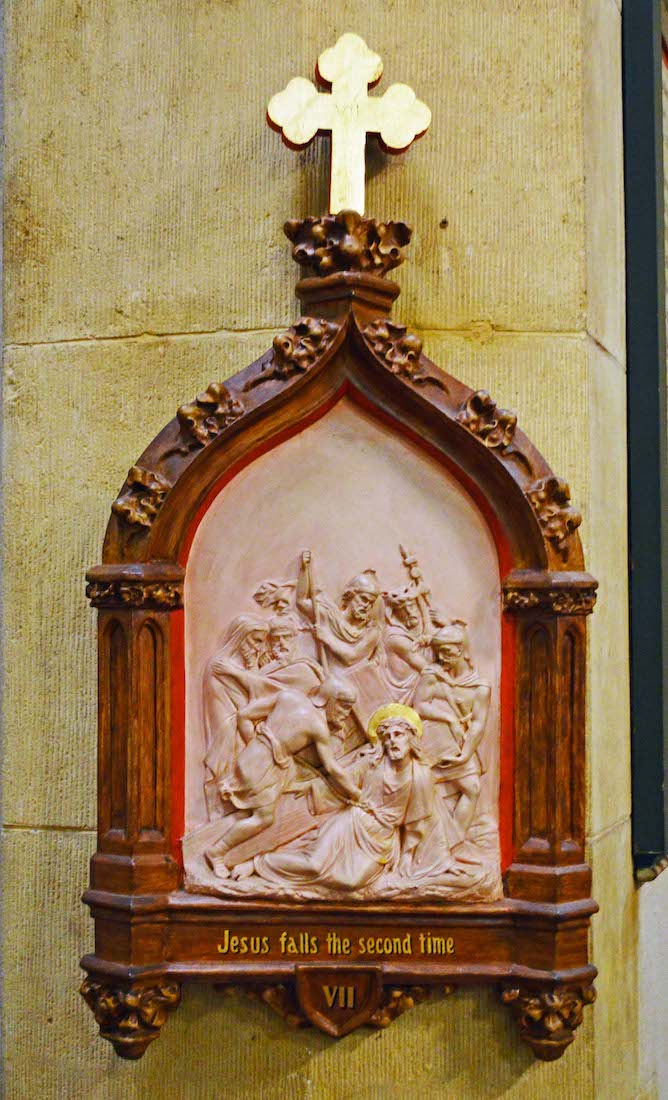
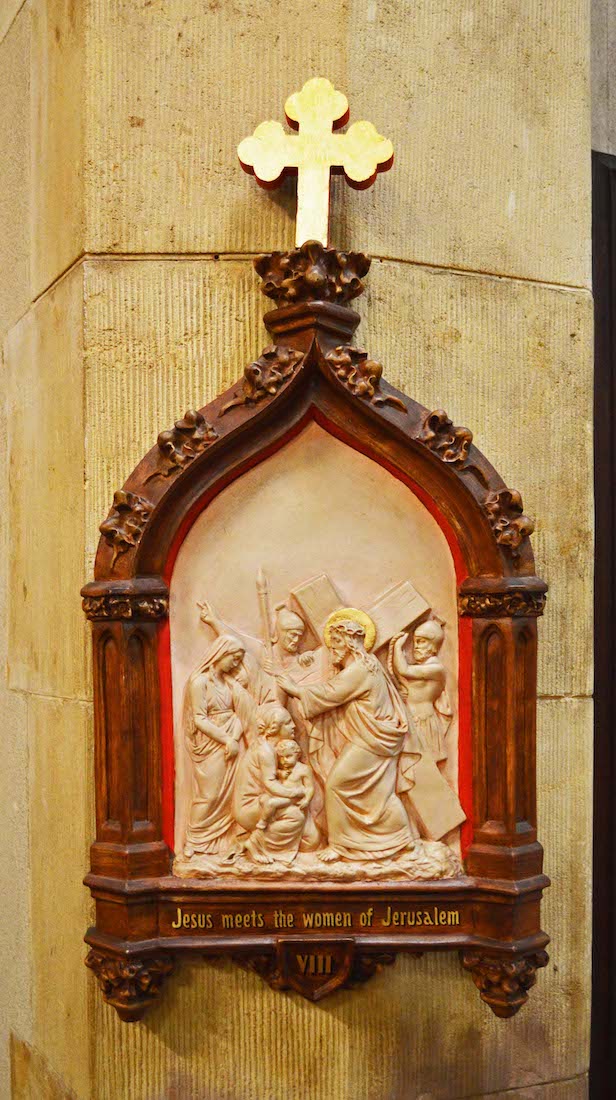
We can see two of the 14 Stations of the Cross on this West wall. Father Wise purchased this series of Stations of Italian origin, and executed in plaster, as a memorial to Mrs Priscilla Bickford who died in 1924. The cost was £75. The object of the Stations is to help the faithful to make a spiritual pilgrimage of prayer, through meditating upon the chief scenes of Christ's sufferings and death. These are Stations VII: Jesus falls the second time, and VIII: Jesus meets the women of Jerusalem.
42. ROLL, PAINTING
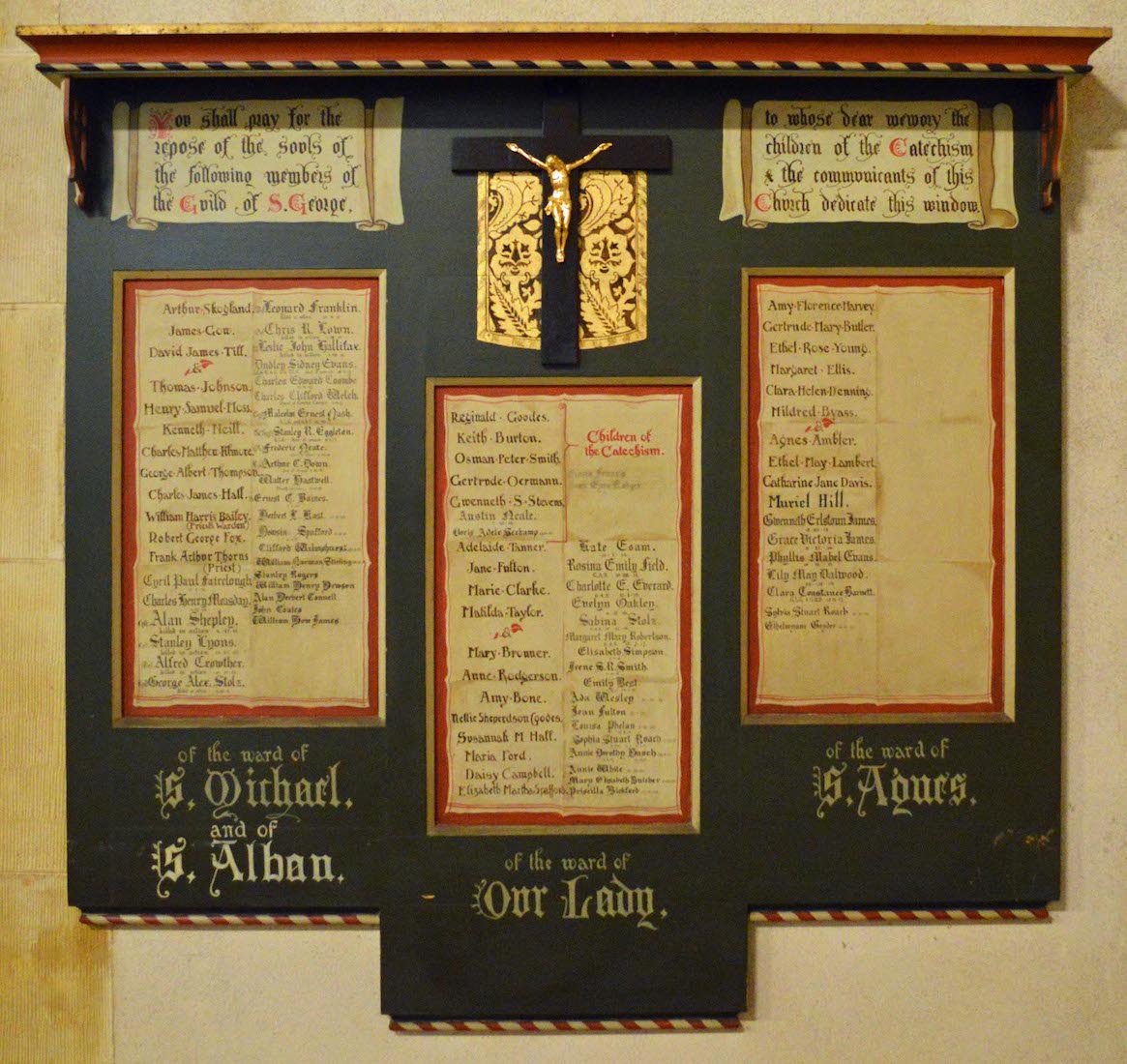
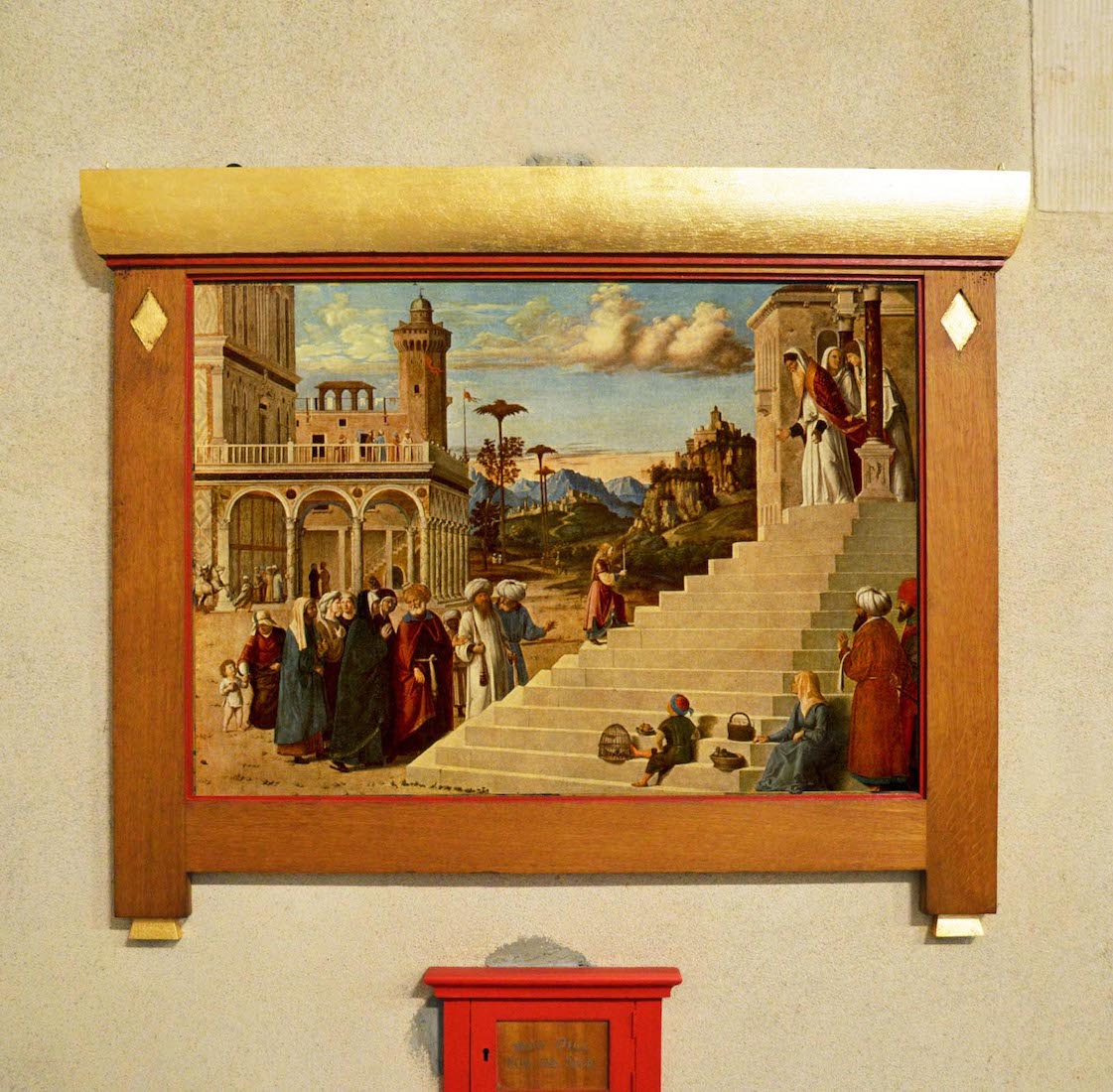
On the South wall of the baptistry there is a roll of names. The crucifix at the top was missing and replaced in 2011. The cross was made by Peter Pitfield and an existing corpus was gilded to make the new corpus. On the North wall of the baptistry hangs the painting ‘The Presentation of Mary in the Temple’ by Cima da Conegliano. The original is in the Dresden Gallery, Dresden, Germany. There is text: ‘Without turning back, she ascended the fifteen steps of the Temple, and presented herself to the Priest, Saint Zachary.’
43. SHRINES
On either side of the baptistry is a shrine: St Agnes on the left, and St Alban on the right. The Shrine of St Agnes was dedicated to Clara Constancy Barnett after World War I. Around the same time the Shrine of St Alban was dedicated to Leslie John Halifax. St. Agnes was a Roman girl who was only thirteen years old when she suffered martyrdom for her Faith. Agnes had made a promise, a promise to God never to stain her purity. She was put to death for refusing the Governor’s son. Saint Alban is venerated as the first British Christian martyr. He was martyred by beheading some time in the 3rd or 4th Century.
44. FONT
The baptismal font was given at the opening of the Church. The font and cover were designed by Lyon. The font was a gift of the Ministering Children’s League and friends, in memory of the Rev. W.S. Moore, for years Rector of St George’s and past headmaster of Pulteney School. The triptych behind the font was the gift of Father Wise in 1905. It is made of oak with the crucifixion scene in plaster. The two stone memorial tablets in the floor of the baptistry were given by Father Wise – brought from England in 1905. One tablet tells that Thomas Henry Lyon gave the plans of the Church. The other tablet remembers Rector William Samuel Moore.
45. WEST WINDOWS
The West windows show St Michael (left) and St George (right), each in three scenes separated by symbolic shields. St George appears as an earthly soldier with palm and banner smiting a black dragon; then as a warrior kneeling before the Holy Grail; and topmost in the robes of heaven. St Michael is also seen fighting a red dragon with a spear, then holding a censer before God, and lastly, with the scales of judgment as he presents souls to God in heaven. The Christ Child statue above the font is a memorial to Ethelwynne Goyder – an oak figure which was formerly on the Lady Chapel gates. This completes our tour of St George’s Church.
46. OLD CHURCH
St George’s Church started life on a Sunday in 1880 when a service was conducted in the home of William Bishop. About 50 people attended, and there was enthusiastic support about building a new church in the area. In 1881 the foundation stone of the new church was laid – in fact across Goodwood Road from the present building. It was opened for worship in January 1882, and services continued here for the next twenty years. Records from 1887 show that some 114 to 137 people attended the monthly communion service. A Sunday School was held for the children.
47. NEW CHURCH BUILT, 1903
This photo of the interior of the new St Georges was taken in 1903, the year the building was completed. Apart from differences in the interior fittings, the Church looks much the same as it is today. The new Church was planned to cost between £4000 and £5000. It was to be in Gothic revival style and roofed with imported Marseilles tiles. The contractor was Mr W. C. Torode who had built the church at Crafers and had recently been working on the towers of St Peter’s Cathedral. The foundation stone was laid on 27 October 1902 by the Archbishop of Sydney and Primate, Dr W. Saumerez-Smith. [Photo Credit: Interior 1903 slsa B22152]
48. THE EXTERIOR, 1904
As the new church was paid for by the time it was ready for services, Bishop Harmer was able to consecrate it on 1 September 1903. The Governor and about 800 laymen were present at this initial service. We notice that the figure of St George was yet to appear in its niche near the apex of the gable. The church and many of its furnishings were designed by Thomas Lyon, and is rare in being mainly the work of one architect. Development continued after the opening with the acquisition of the organ, the development of the chapels, and more recently the addition of the large gold crown and cross in the sanctuary. [Photo Credit 1904 slsa B48748]


